Articles & eye-witness accounts from inside Iraq
Page 3
(October 2005 - May 2006)
 Iraqi
Doctors Beaten and Arrested in Haditha Hospital (30 Oct.2005) |
Al qaim October Massacre: Indiscriminate Killing Zone (04
Nov.2005) | Haditha: River
Gate… to Hell (06 Nov. 2005) |
Yosfiya:
The 21st Century Nazis Are Here (20 Nov.2005)
| ‘Even
during operations, doctors were shot at by US soldiers’ (07 Dec 2005) |
Al Qaim revisited -
Behind the Steel Curtain: The Real Face of the Occupation
(18 Dec 2005) |
Foto album of the devastated city of Al Qaim
(18 Dec 2005) |
Inside Iraq's secret prisons: an Iraqi
testimony (19 Dec 2005) |
Attending a Human Rights Meeting, or: one morning in
Baghdad... (07 Jan 2006) |
Broken Promises
(01 Feb 2006) |
Death Squads and Iraqi
police: two sides of the same coin
(03 March 2006) |
Children of Abraham: Death in the
Desert (Isahaqi - 15 March 2006) |
Militants of
Jafaari commit massacre in Al-Fursan village. US sponsored death squads in action (23 March 2006) |
Schools in
Iraq (24 March 2006) |
Uniformed Death Squads: Terrorizing Iraq into Disintegration
(10 May 2006)
| The "Deal Government" Fiasco
and Iraq's Future (21/05/2006)
Iraqi
Doctors Beaten and Arrested in Haditha Hospital (30 Oct.2005) |
Al qaim October Massacre: Indiscriminate Killing Zone (04
Nov.2005) | Haditha: River
Gate… to Hell (06 Nov. 2005) |
Yosfiya:
The 21st Century Nazis Are Here (20 Nov.2005)
| ‘Even
during operations, doctors were shot at by US soldiers’ (07 Dec 2005) |
Al Qaim revisited -
Behind the Steel Curtain: The Real Face of the Occupation
(18 Dec 2005) |
Foto album of the devastated city of Al Qaim
(18 Dec 2005) |
Inside Iraq's secret prisons: an Iraqi
testimony (19 Dec 2005) |
Attending a Human Rights Meeting, or: one morning in
Baghdad... (07 Jan 2006) |
Broken Promises
(01 Feb 2006) |
Death Squads and Iraqi
police: two sides of the same coin
(03 March 2006) |
Children of Abraham: Death in the
Desert (Isahaqi - 15 March 2006) |
Militants of
Jafaari commit massacre in Al-Fursan village. US sponsored death squads in action (23 March 2006) |
Schools in
Iraq (24 March 2006) |
Uniformed Death Squads: Terrorizing Iraq into Disintegration
(10 May 2006)
| The "Deal Government" Fiasco
and Iraq's Future (21/05/2006)
Return to Page 1 (September
2004 - May 2005) - Return
to Page 2
(February 2005 -
October 2005) -
Read more
on Page 4 (June 2006 - February 2007) -
More stories on Page 5
(March 2007 - 2007)
WEBLOGS:
Baghdad burning (Riverbend: Iraqi girl blogspot)
|
Dahr Jamail Iraq dispatches |
Blogspot by
Imad Khadduri |
Iraq
Diaries |
The woman I was |
A citizen of Mosul |
Where is Raed |
A family in Baghdad |
Baghdad Dweller |
Dr. Salam Ismael |
Iraqi Doctors Beaten and
Arrested in Haditha Hospital
Sabah Ali (30/10/2005)
Dr. Walid Al-Obeidi, the director of Haditha General Hospital and Dr.
Jamil Abdul Jabbar, the only surgeon in the Haditha area were arrested for a week, very badly beaten and
threatened to face the same treatment in the future by the American troops.
Dr. Walid said “they arrested me in my house in front of my family,
covered my eyes, and tied my hands to the back on Oct 5 2005 morning, during the last attack on Haditha (360
kilometers west of Baghdad). They occupied the hospital for 8 days and made it their office. The first day
they beat me on my eyes, nose, back, hands, legs... My face was covered with blood .When they removed the
tie I could not see. They investigated me until the afternoon. I realized later that I was arrested in the
hospital store. Then they tied my hands to the front, and left me for two days. I was moved then to the
pharmacy department. They accused me of treating terrorists, and asked for their names.
I told them that I treat patients regardless of their identity,
according to my oath as a doctor; even if they were national guards (which we actually I did) or American
soldiers. And any way, if I do not want to treat the insurgents, I have no choice, because they were armed
and masked. I would do anything they tell to do. Few days later, one of the soldiers came in the room, did
not say anything, kicked me again on my face and left”.
Dr. Jamil, a surgeon for 20 years, was arrested and very badly
beaten. When we met him, 22 days later, his face was still blue. His nose was broken, and a big opening in
his head: “They beat me on my eyes and nose, kicked me with boots under my chin. One of them threatened me if
I do not talk after he counts to three, he would shoot me. He began counting, after three he turned the gun
upside down and hit me on the back of my head. For days I could not move or see. They threatened us of
abusing our families. For some reason they took my picture while I was bleeding, I could hear the camera
click”.
Both doctors were threatened if they do not talk, they would receive
the same treatment in the future. They were warned of passing any information of the arrest to the media.
They were asked who wrote the hostile slogans against the American on the opposite wall of the hospital? What
are the names of the insurgents they treated? and what are the bodies’ pictures in the hospital computer?
Dr.Walid said he does not know who wrote on the wall outside the
hospital, what the names of the insurgents are, because they were masked. He explained that the dead bodies’
pictures were of unknown people whose bodies were found after the fighting. “We can not keep these bodies
forever; we do not have enough cold boxes. So, after two months, we take their pictures and bury them, so
that whenever some one from their families comes to ask we show the pictures of the dead bodies”.
The UN, the international HR
organizations, WHO, Doctors sans frontiers…and all who it may concern are called upon to do some thing to
help these, and other Iraqi doctors, and to prevent similar treatment in the future. Dr.Walid and Dr. Jamil
believe that they may face the arrest and beating in the future. They demand that the American troops stop
occupying the hospital and destroying it every time the attack Haditha. They also believe that the Iraqi
authorities are incapable of protecting them.
Alqaim October Massacre: Indiscriminate
Killing Zone
Dedicated to the UN, UNSC, and the International
Society….
Sabah Ali
(05/11/2005)
 We had to postpone our trip to Al-Qaim and Haditha several times for 2
weeks. Many times the road was closed because of some military operations. We decided to go to the refugee
camps first, be ready to move from there as soon as the road is clear. There were 8100 refugee families now
(last time, before Oct 1, they were 7450) distributed on the nearest towns, villages and in the desert. Some
of the camps were cut from any kind of relief, especially those which were across the Euphrates, because the
American troops bombed all the bridges in Alqaim (3) and Haditha (2). The need now is for thick
clothes, especially for children, blankets, and medicines for daily use, apart from food. The new families
were those who escaped the latest attack on Alqaim (Oct1) and Haditha (Oct 5) The River’s
Gate, as it was called. One of the biggest emergency relief organizations in Iraq now admitted that they
can not reach the behind-the-river villages.
We had to postpone our trip to Al-Qaim and Haditha several times for 2
weeks. Many times the road was closed because of some military operations. We decided to go to the refugee
camps first, be ready to move from there as soon as the road is clear. There were 8100 refugee families now
(last time, before Oct 1, they were 7450) distributed on the nearest towns, villages and in the desert. Some
of the camps were cut from any kind of relief, especially those which were across the Euphrates, because the
American troops bombed all the bridges in Alqaim (3) and Haditha (2). The need now is for thick
clothes, especially for children, blankets, and medicines for daily use, apart from food. The new families
were those who escaped the latest attack on Alqaim (Oct1) and Haditha (Oct 5) The River’s
Gate, as it was called. One of the biggest emergency relief organizations in Iraq now admitted that they
can not reach the behind-the-river villages.
Arriving in Alqaim general hospital on Oct 25 afternoon, after being lost on
a desert detour for more than 2 hours, and coming from the nearest refugee camp where we listened to
different stories of the last attack on Oct 1,2005, we were well prepared to listen to the crowed at the
emergency room. A big black banner says that the ambulance driver, Mahmood Chiad, was shot on Oct
1,2005 by the American troops while he was trying to help some injured families.
 A young man, H.Khalaf, was lying on a trolley, soaked in blood. He was shot
in his genitals by an American sniper while he was going home from the market just across the street. The
shot injured his right thigh, his testes, and went out through his left thigh.
A young man, H.Khalaf, was lying on a trolley, soaked in blood. He was shot
in his genitals by an American sniper while he was going home from the market just across the street. The
shot injured his right thigh, his testes, and went out through his left thigh.
“There was nothing, no shooting, no bombing, nothing” a neighbor who brought Khalaf
to the hospital said. “We heard the shot, and he was lying there bleeding. We could not reach him. He crawled
to the side street for few minutes”. The doctor does not know yet how bad the injury is. The bleeding was
still running.
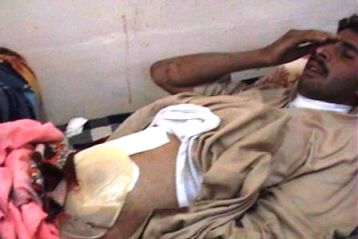 In the ward another young man, Salah Hamid, was shot under the belt too. He
was driving his taxi at 10 am on Monday Oct17, 2005 in the market place when he was shot by the American
snipers. Salah was so angry that he cried and used obscene words (unacceptable in those areas). His car
was completely ruined. The doctor explained that a large part of his intestine had to be cut.
In the ward another young man, Salah Hamid, was shot under the belt too. He
was driving his taxi at 10 am on Monday Oct17, 2005 in the market place when he was shot by the American
snipers. Salah was so angry that he cried and used obscene words (unacceptable in those areas). His car
was completely ruined. The doctor explained that a large part of his intestine had to be cut.
In the doctors’ hall, the windows, the curtains, the walls were covered with bullet
shots.
The hospital’s assistant director described how bad and difficult the situation is,
the continuous bombing of houses and cars, the snipers who shoot indiscriminately any moving thing (two days
ago they killed 6 donkeys), the besieged city, the closed highway “I do not understand why they cut the high
way and let families go through the desert, they are searching everything and everybody! Now, on top of
everything else, the oxegen tubes are not allowed in the hospital”. 


(Municipal hotel destroyed)
The administrative assistant explained the situation in the bombed areas across the
river (Euphrates) after the bridges were bombed in
the attack “There are many villages: Rumana, Al-Beidha, Al-Ish, Dgheima, Baghooz, Al-rabot….etc where
families sought shelter from the bombing. These villages are cut of any kind of help now, and are exposed to
regular bombing. There is no doctor or clinic in an area of 110 kilometers along the river. The injured
families have to be brought by boats, bleed to death, or die under the rubbles. It is impossible to count the
dead, their families bury them on the spot, without any document, and of course no media coverage. Civilians,
relatives and neighbors help evacuating those buried under the rubbles. Snipers are still hurting us most. On
the Referendum day Oct 15, no one would dare to go out; I would not, even if I was given the post of a
president”.
 The ambulance driver, Mahmood Chiad, 35, was going to Karabla, to help some
injured family during the attack. He was shot and killed by a bullet in the left chest. The ambulance was
then hit by a grenade which ripped it in two parts, and burnt it. It was still there, but we could not film
in the no man’s land, as they call it. Mahmood left a widow and six children; the oldest of them, Aimen
(m), is 10 years old. “The family was not given any compensation or pension” said his colleague Muneer
Said “he was very poor, living in a tin extension of a house, his family should be taken care of”.
The ambulance driver, Mahmood Chiad, 35, was going to Karabla, to help some
injured family during the attack. He was shot and killed by a bullet in the left chest. The ambulance was
then hit by a grenade which ripped it in two parts, and burnt it. It was still there, but we could not film
in the no man’s land, as they call it. Mahmood left a widow and six children; the oldest of them, Aimen
(m), is 10 years old. “The family was not given any compensation or pension” said his colleague Muneer
Said “he was very poor, living in a tin extension of a house, his family should be taken care of”.
Early next morning, around 7 am, there was noise and crowd in the hospital. Two cars
covered with dust, and few men were standing at the emergency gate. One old man, over 60, was sobbing and
talking to the sky, repeating hysterically “please come and see what happened to me”, other men were crying
silently.
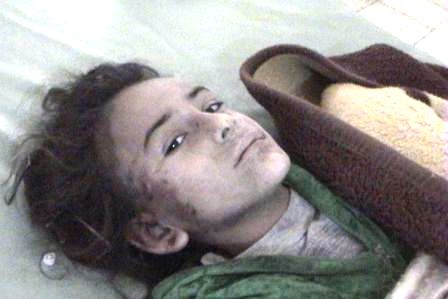 In the emergency ward, a girl of ten was lying on one trolley, and a young woman on
another. They were still conscious. The girl, Yosr Jasim Mohammad Al-Ta’i, 10, (going to 5th
grade, as she said proudly), was injured in her feet, back, and right ear, which were covered with blood.
She did not know that she is the only survivor of a family of 8. Her father, her mother Ibtisam Thiyab
Othman, and five of her brothers and sister were buried dead under the rubbles when the American
airplanes bombed Al-Ish village at 2 am that day, Oct 26.2005.
In the emergency ward, a girl of ten was lying on one trolley, and a young woman on
another. They were still conscious. The girl, Yosr Jasim Mohammad Al-Ta’i, 10, (going to 5th
grade, as she said proudly), was injured in her feet, back, and right ear, which were covered with blood.
She did not know that she is the only survivor of a family of 8. Her father, her mother Ibtisam Thiyab
Othman, and five of her brothers and sister were buried dead under the rubbles when the American
airplanes bombed Al-Ish village at 2 am that day, Oct 26.2005.
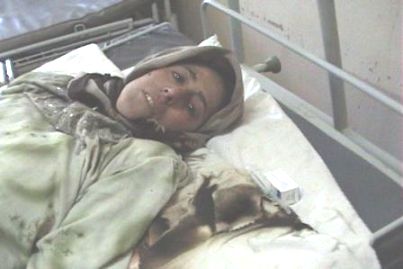 The woman, Sa’diya, 35, was injured in her thigh. She was rapped in a burnt
out quilt. Sa’diya was in her uncles’ house. Her house was blown up by the American troops the day
before “they took the women and children out, and blow the house, I do not know if they arrested the men or
they blow them inside the house. We came to my uncles’ house yesterday, today at 2 am we were bombed again”.
Sa’diya was terribly shocked. “I do not know how many people were killed. We were more than 30 in the
house. My three uncles, their wives and children, my aunt, and five guests in the diwan (guest room),
were killed. I do not know if there are any survivors, I was buried under the wall. I saw my uncle Idan,
and two of the children Farooq (m)8, and Ahmad (m) 7, they were dead”. (Sa’diy did not
know that Yosr, one of the guests and herself are the only survivors of the many families in that house).
The woman, Sa’diya, 35, was injured in her thigh. She was rapped in a burnt
out quilt. Sa’diya was in her uncles’ house. Her house was blown up by the American troops the day
before “they took the women and children out, and blow the house, I do not know if they arrested the men or
they blow them inside the house. We came to my uncles’ house yesterday, today at 2 am we were bombed again”.
Sa’diya was terribly shocked. “I do not know how many people were killed. We were more than 30 in the
house. My three uncles, their wives and children, my aunt, and five guests in the diwan (guest room),
were killed. I do not know if there are any survivors, I was buried under the wall. I saw my uncle Idan,
and two of the children Farooq (m)8, and Ahmad (m) 7, they were dead”. (Sa’diy did not
know that Yosr, one of the guests and herself are the only survivors of the many families in that house).
Khalifa Mokhlos the only survivor among the 4 men
in the guest room said that the other 4 men were killed when two missiles hit the house. “Jasim M. Mokhlos
(30), Idan Abdulla Mosa (52), Awad M.Mosa (45), and Moslem K.Hussein (30) were all
killed”.
K., the chief of community council in Al-Risala
district, himself handicapped in the Iraqi-Iranian war, was telling us many stories of demolished houses and
killed families. We asked to visit some of them. He was hesitant, but then suggested that we only visit those
in the relatively safe districts. Alqaim now looks so different from Alqaim we saw 18 months
ago in the first major American attack in April 2004. Then it was a city full of life, shops, offices,
people, police…there was movement in the street. Now it is a dead city. Fear and suspicion are the kings of
the streets.
 The first family was of Saggar Hamdan, a Land Cruiser driver who was taking
his- and his brother in law’s- families to the Okashat refugee camp 200 kilometers away in the desert
at 4 pm on the attack first day. His father explained that” there were 19 women and children in the car when
it was shot and burnt by the American troops. Saggar , his wife Khadija, and his 6 children
(Ala’(m)10, Adil (m), Omar(m), Sheima’(f), Lamia(f)’, and a baby) and his niece were killed. No
one was allowed to approach the car until it was no more than ashes”. It was only after 5 days that a cousin,
Hashim Hamid, was allowed to get the bodies.
The first family was of Saggar Hamdan, a Land Cruiser driver who was taking
his- and his brother in law’s- families to the Okashat refugee camp 200 kilometers away in the desert
at 4 pm on the attack first day. His father explained that” there were 19 women and children in the car when
it was shot and burnt by the American troops. Saggar , his wife Khadija, and his 6 children
(Ala’(m)10, Adil (m), Omar(m), Sheima’(f), Lamia(f)’, and a baby) and his niece were killed. No
one was allowed to approach the car until it was no more than ashes”. It was only after 5 days that a cousin,
Hashim Hamid, was allowed to get the bodies.
“I had to jeopardize my life, hold a white flag and stand in the American convoy
way” Hashim said. “I told them that I wanted the bodies of my cousin and his family. The American
Commander said “ I am sorry, it was a mistake, we did not know that it was a family”, and he gave me a
plastic sac full of the charred bodies.
………….
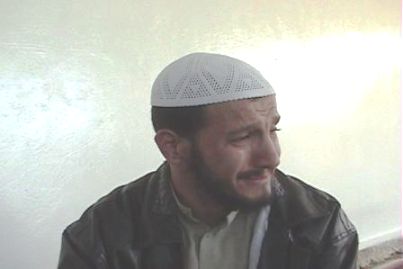 The second family was of Mohammad Jabir, a boy of nine years who was shot by
an American sniper at his house door in the “Death Street” on Thursday Oct 20, 2005.
The second family was of Mohammad Jabir, a boy of nine years who was shot by
an American sniper at his house door in the “Death Street” on Thursday Oct 20, 2005.
“He was going to his uncles’ house, across the street in the railway houses” his
father said, trying hard to hold his tears “They were 4 of my children, went out to visit their uncle’s
family, they were shot at immediately. They returned back, Mohammad was putting his hand on his chest,
said I am injured, and then fell to the ground. He was bleeding. We tried to save him, but no ambulance or
car was allowed to pass through. His uncle did not mind the shooting; he drove his car and took us to the
hospital. By then Mohammad was dead”.

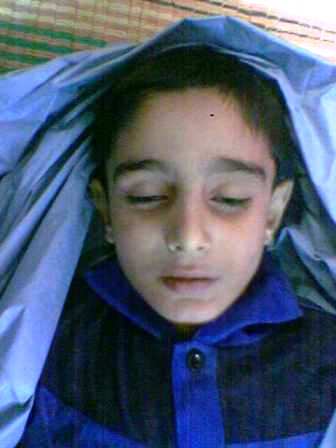
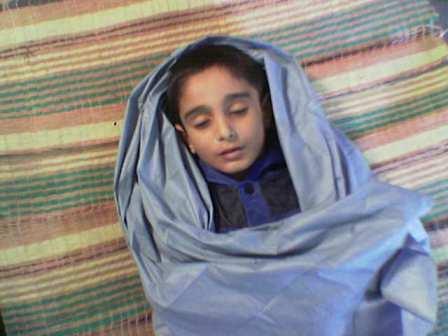
The mother was heavily covered with black: “when we tried to take him to the
hospital, the soldiers shot at us. I was shouting, but no one dared to approach. We sat on the ground waiting
for the shooting to stop, until his uncle came with the car”
Mohammad is the 13th child killed by a
sniper in the railway houses “they call it the Death Street, one of the children who were killed was only 1.5
years, another was 3. I can take you to visit their families all. On October 23, 2005, at 2 pm, the American
airplane was going and coming back many times on the street shooting all the time”. Jabir left his
house and is now living in the family’s big house with other 5 families in another area.
……….
 The third family was of Attiya Mikhlif. The house was no more than a heap of
rubbles. It was bombed at 6 am on August 30, 2005. There was no one of the family left to tell the story.
Neighbors were hesitant to talk. “The old man died years ago” one of the neighbors volunteered to talk at
last. “There was his old wife, Dalla Hardan 55, his three sons, Daham 35, Rashid 25, and
Salman 18, and two daughters in law: Rafaah 19 and Kholood 19. Rashid, his bride Rafaah,
Salman and his bride Kholood were all newly married”. All of them were killed that morning.
The third family was of Attiya Mikhlif. The house was no more than a heap of
rubbles. It was bombed at 6 am on August 30, 2005. There was no one of the family left to tell the story.
Neighbors were hesitant to talk. “The old man died years ago” one of the neighbors volunteered to talk at
last. “There was his old wife, Dalla Hardan 55, his three sons, Daham 35, Rashid 25, and
Salman 18, and two daughters in law: Rafaah 19 and Kholood 19. Rashid, his bride Rafaah,
Salman and his bride Kholood were all newly married”. All of them were killed that morning.
-“why do you think the house was bombed?”
- “Who knows, the Americans say that there were insurgents in the house, but they
were families as you see. And anyway, you do not air bomb houses to kill insurgents who are supposed to be
in!!”
………..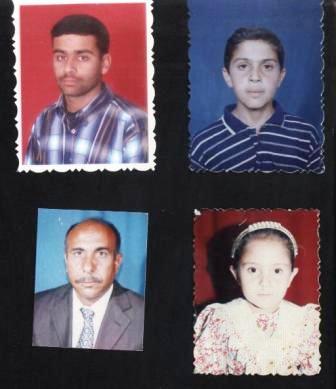
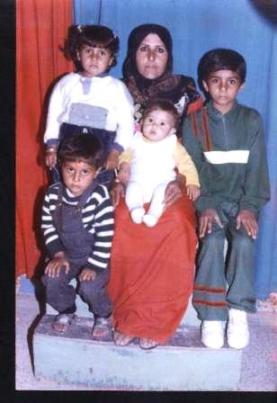

The fourth family was of Kawan Abu Mohammad. On September 8, 2005, the house
in an agricultural area called the Senjaq was bombed killing 11 civilians, most of them children. The
old man, Kawan 70, his son Mohammad 50, a teacher of physics, his daughter in law Hamdiya 40
(Mohammad’s wife), and their 4 children: Dhoha 16(f), Ro’a 10(f), Obeida 12(m), and
Hotheifa 4 (m)were all killed under the rubles. Khalid, 18, Kawan’s grandson whose uncle
Mohammad was helping him in physics, Amjad(m) 22, Zeinab 17(f), and Saja 8 (f)were
all Kawan’s grandchildren, who were visiting their grandfather were all killed in that bombing too.
Two members of the family survived: Mahmood Kawan 25(m) was paralyzed and Nahida 16, Amjad’s
sister was mildly injured.

 K., of the community council, took us then to
Al-Risala district where 8 houses were bombed together on Saturday 22, 2005 around 3 am, and the Big
Mosque on 23rd . Fortunately, they were empty. “The Americans believe that the insurgents hide
in these empty houses” K. explained. Many families returned from the refugee camps to find their
houses destroyed.
K., of the community council, took us then to
Al-Risala district where 8 houses were bombed together on Saturday 22, 2005 around 3 am, and the Big
Mosque on 23rd . Fortunately, they were empty. “The Americans believe that the insurgents hide
in these empty houses” K. explained. Many families returned from the refugee camps to find their
houses destroyed.
 In
In
 one of the houses in Al-Salaam district, Alwan Abdul Kareem refused
to stay with his family in the refugee camp in Anah. He found it unbearable to live as a refugee, so
he returned home alone 4 days later. The house was bombed on the same day (Oct 22), he was killed under the
heavy stairs where he was hiding, eating his sohoor (the last meal before fasting). Alwan was
58, a gardener and a school guard. We met his family in Anah refugee camp. He left a wife Shokriya,
40, and eight children.
one of the houses in Al-Salaam district, Alwan Abdul Kareem refused
to stay with his family in the refugee camp in Anah. He found it unbearable to live as a refugee, so
he returned home alone 4 days later. The house was bombed on the same day (Oct 22), he was killed under the
heavy stairs where he was hiding, eating his sohoor (the last meal before fasting). Alwan was
58, a gardener and a school guard. We met his family in Anah refugee camp. He left a wife Shokriya,
40, and eight children.
In Anah refugee camp 5 families (around 10 each) lived in one house. They did
not receive the monthly food ration for 3 months. K., very anxious to show us how bad the damage was, could
not keep his promise of staying away from the dangerous areas. Near the railway station, a completely damaged
hotel was used by the municipality to host the very poor families for a symbolic price. So is the railway
itself.
Shawkat A. Abbood, who just arrived from Alqaim, told us about the
attack on Si'da, a village 10 kilometers to the east, said that on October 1, the market place was closed at
10 am, the city was besieged from two remaining places: Si’da and Karabla, 10 kilometers away.
The electricity and phones were cut, all offices were closed, and cars were prevented from moving … “When the
bombing began, we remained at home. Translators in military vehicles told the people through megaphones to
stay at home, that their lives would be in danger if they move out. We could hear the bombing, but we did not
know where exactly. The bombing continued for 4 days. Airplanes were roaming 24 hours; the intensive bombing
was at night. In the Rumana village they bombed 4 houses. There were 12 injured the first day. We do not know
exactly about the dead, may be 30-40”
-“It was a declared attack, why the families did not leave?”
- “some families do not have any alternative, or too poor to move, some put tents
in the farms of the Senjaq area. And any way what was declared was that the American troops are going
to enter Alqaim with the Iraqi troops, they called the civilians to cooperate with the troops to
arrest the insurgents”. Shawkat’s mother, 55, was crying, listening to her son. She is diabetic, and
too frightened “when I hear the bombing, I shiver, feel the pain in my back; I feel the ceiling coming down
and crushing me”.
In Alqaim we met A.M. an employee in the electricity office. “We tried
3 times to repair the electricity; the Americans were shooting at us every time. The third time they said you
have 30 minutes to repair it. It takes two hours, as you know, on the desert road to reach the station. But
we managed to do. The other station is near the customs office (which is now a military base) we could not
reach that point”. The same story is repeated with the water.
Shareef, a fireman, and an emergency relief
volunteer was very angry “where are the nations of the world, the Moslems, the Arabs…millions of them pray
everyday, do not they see what is happening to us”.
…………
To Be Continued on Haditha
Haditha: River Gate… to Hell
Sabah Ali (06/11/2005)
It usually takes less than an hour from Alqaim (Husaiba,
as locals call it) to Haditha. We left at 8.45 am to be at the first Haditha checkpoint at 5
pm. We had to take an hour detour on the dusty desert road, on which we were lost last time, to reach the
cement factory check point, normally10 minutes away on the paved road. But that was the easiest part of the
story. Before we were there an American convoy stopped us. We had to go out of the pavement for a few meters,
turn the cars to face the desert until the convoy passed and was far away. We hardly moved again, when
another convoy came from the opposite side. We had to leave the pavement and face the desert again. When they
were away, inside the Cement factory, we began to move.
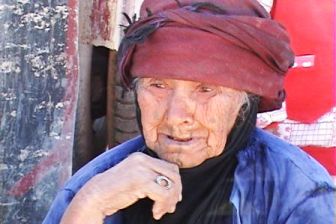
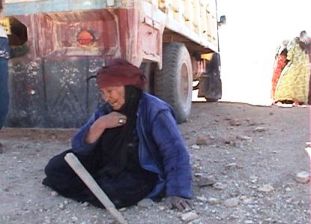
But the Iraqi National Guards prevented us. “Go back” they ordered,
at gun points. It was not too hot on that late October day, but the wind and the sun were not helping the
fasting people, it was still Ramadan last fasting days. We had to wait for 5 hours. The majority of the
people on the road were families, going back with their animals and furniture to Si’da, after the
latest attack was over, (or so they believed). Tens of trucks and small cars were waiting hopelessly in the
middle of the desert. A deaf old woman in her 80's was crying bitterly, wondering God’s wisdom of not taking
her soul and helping her out of this situation!! “the cold killed me” she could hardly talk.
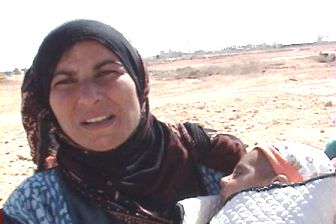
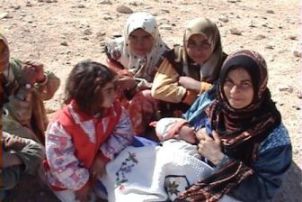
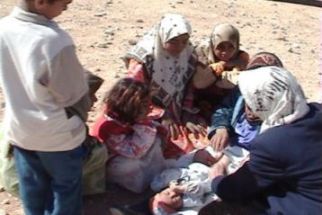
A
young mother of 6 children, Ida Thiyab, was changing her baby’s diapers; she left her home when he was only
one day old. Now he is two months. A third was looking for clean water to feed her baby. Soriya, a
mother and grandmother of a big family, suffers from asthma, and in the refugee camp the doctor did not know
how to help her…etc.
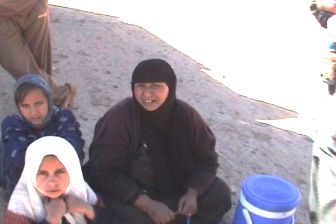
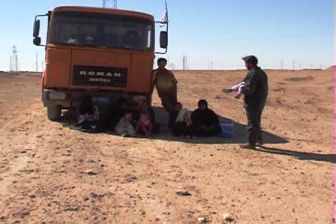 “Is
it not dangerous to go back home now, while the situation is still not safe?” (One of the biggest attacks
eventually began on Nov 5, 2005 named Steel Curtain, 3500 American and Iraqi troops participated in
it)
“Is
it not dangerous to go back home now, while the situation is still not safe?” (One of the biggest attacks
eventually began on Nov 5, 2005 named Steel Curtain, 3500 American and Iraqi troops participated in
it)
-
“What else can we do?” replied Ida. It is getting too cold especially at night in the wilderness; we
were living in a (tent) that we made of flour sacs for two months”.-
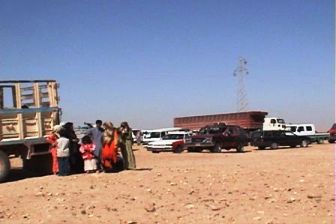
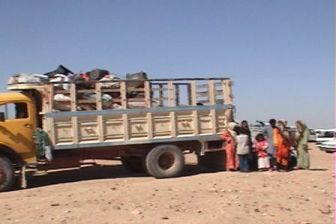 Realizing
that there is no chance of opening the road that day, the drivers decided to move, and try another checkpoint. This one was open allright, but the queue was so long that you could not see its end. The search was so
minutely that it takes at least 10 minutes for one car from either side to move. Some families tried to talk to
the American soldiers to make it easier for the children and old people. He was kind and promised to help
“but I have orders” he said. Breakfast time was approaching, all the people were fasting.
Realizing
that there is no chance of opening the road that day, the drivers decided to move, and try another checkpoint. This one was open allright, but the queue was so long that you could not see its end. The search was so
minutely that it takes at least 10 minutes for one car from either side to move. Some families tried to talk to
the American soldiers to make it easier for the children and old people. He was kind and promised to help
“but I have orders” he said. Breakfast time was approaching, all the people were fasting.
We drove at 150k/h; we had to go through 3 more check points to reach
the last one at Haditha gate. There, few humvees (American armored vehicles) surrounded us from 3
sides. Some of the soldiers went down, took the firing position and began shouting in broken Arabic: “get
down and leave the doors open”. We did immediately. They told us to move forward. We did.
In one of the cars a woman became very angry, she did not obey,
began shouting at the soldiers: “I am a doctor, I am supposed to be at work now, while I spent the day here
in these queues, why do you not respect our time, can you not see that we are civilians, how many times do
you have to search us…etc”. Another woman was very worried about her, tried to go back and help, but ordered
not to move “what is this? Are we arrested?” she complained, but did not get a reply. There was fuss,
wireless calls between the soldiers and officers, in the end two very big built officers came near and asked
who the woman was who was pissed off.
She did not stop shouting at them. “We are fed up” she said. The
officer, curiously enough, asked her calmly if she had any questions, and why she was angry, “it is for your
own sake, and ours too, this delay” he said. Her car was scrupulously searched, and let go.
The Iraqi soldiers, whose accent was clearly southern, asked for
badges. As we were not from Haditha, they told us that we had to go back “the road is closed in 15
minutes” he said. We decided to leave the car, cross the checkpoint on foot, and tried to get a car on the
other side. Haditha is now no more than 15 minutes away.
The situation here was different than it was in Al Qaim. The
American and Iraqi soldiers were everywhere in the streets. There was no more car searching, only
checking the IDs. Traces of the last attack could be seen everywhere on the buildings, the faces, and the
suspicious eyes.
We heard the same scenario. Water, electricity, phones, roads were
all cut off. The city was besieged before the bombing began on October 5, 2005 and went on for 18 days. Many
houses were demolished, many families left to the refugee camps, many people were arrested, including the
Moslem Scholars Association secretary in Haditha and his son. The general hospital was occupied for 10
days; the hospital director and one of the doctors were brutally beaten and locked up for a week inside the
hospital. Many schools and offices were still occupied. All houses were raided, some twice a day. All weapons
were confiscated including the personal. There is no government, no offices, no schools, no work, no
markets…nothing. “Haditha is a fallen city” was sarcastically repeated.
Dr. Walid Al-Obeidi, the director of Haditha
General Hospital and Dr. Jamil Abdul Jabbar, the only surgeon in the Haditha area, were
arrested for a week, very badly beaten and threatened to face the same treatment in the future by the
American troops.
Dr.Walid said “they arrested me in my house in front of my
family, covered my eyes, and tied my hands to the back on Oct 5 2005 morning, during the last attack on
Haditha (360 kilometers west of Baghdad). They occupied the hospital for 8 days and made it their office.
The first day they beat me on my eyes, nose, back, hands, legs... My face was covered with blood. I could
not wash my face because bleeding would start again. When they removed the tie I could not see. They
investigated me until the afternoon. I realized later that I was arrested in the hospital store. Then they
tied my hands to the front, and left me for two days. I was moved then to the pharmacy department. They
accused me of treating terrorists, and asked for their names.
I told them that I treat patients regardless of their identity or
their political position, according to my oath as a doctor; if they were national guards (which they actually
were) or American soldiers. And anyway, if I do not want to treat the insurgents, I have no choice, because
they were armed and masked. I would do anything they tell to do. Few days later, one of the soldiers came in
the room, did not say anything, kicked me again on my face and left”
Dr. Jamil, a surgeon for 20 years, was also arrested and very
brutally beaten. When we met him, 22 days later, his face was still bluish. His nose was broken, and a big
opening in his head: “They beat me on my eyes and nose, kicked me with boots under my chin. One of them
threatened me if I didn't talk after he counts to three, he would shoot me. He began counting, after three he
turned the gun upside down and hit me on the back of my head with the gun. For days I could not move or see.
They threatened us of abused our families. For some reason they took my picture while I was bleeding, I
could hear the camera click”
Both doctors were threatened if they didn't talk, they would receive
the same treatment in the future. They were warned not to pass any information of the arrest to the media.
They were asked who wrote the hostile slogans against the American on the opposite wall of the hospital
(there were different slogans on that wall from opposite sides, the American soldiers –the F word- and the
insurgents). What are the names of the insurgents they treated? And what are the bodies’ pictures in the
hospital computer?
Dr.Walid said he did not know who wrote on the wall outside the
hospital, what the names of the insurgents were, because they were masked. He explained that the dead bodies’
pictures were of unknown people whose bodies were found after the fighting. “We can not keep these bodies
forever; we do not have enough cold boxes. So, after two months, we take their pictures and bury them, so
that whenever someone from their families comes to ask we show the pictures of the dead bodies”.
The UN, the international HR organizations, WHO,
Doctors sans frontiers…and all who it may concern are called upon to do something to help these, and other
Iraqi doctors, and to prevent similar treatment in the future. Dr.Walid and Dr. Jamil believe that
they may face the arrest and beating in the future. They demand that the American troops stop occupying the
hospital and destroying it every time they attack Haditha. They also believe that the Iraqi
authorities are incapable of protecting them.
The hospital became a center of almost everything after the attack.
Relief distribution, electricity and water pipes repairing, fuel…etc. Dr.Walid had to arrange for these
details and send workers in the ambulance. An officer asked dr.Walid what he thinks of the Americans, and he
replied “you are occupation troops, I wish that you were friends, but this way, things do not work”
“Is it not better that we are here?” he asked again.
“No” dr. Walid replied “look at you, heavily armed in your military
clothes, you frighten children. You create tension”. Dr. Walid was offered $30 as an apology
compensation for beating and humiliating him. “I did not know what to do, I did not want to reject them and
create more problems, and I could not accept them, so I gave them to the cleaning workers”. One of the
American soldiers whispered to dr.Walid, that the compensation they should pay if such an aggression happens
in the US, would buy the whole city of Haditha.
The troops are everywhere (in the hospital, the assistant room
became the investigation room) . They occupy any house for 2 or 3 hours. You find them in the house garden or
on the roofs at any time. They are occupying 8 schools now, the Education Office, the water project, the
municipality, the court…filling the windows with sand sacs, and turned them into hq's. Many people
whose stuff, money, documents…etc were confiscated during the house raids, were given small sheets of paper
saying that they could collect them in this or that school.
Yosfiya:
The 21st Century Nazis Are Here
Sabah Ali (20 Nov 2005)
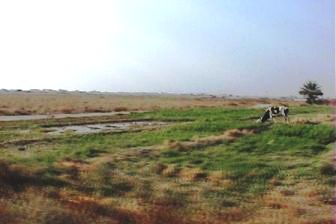 Those
who follow the American occupation of Iraq news may be familiar with a term used in media almost two years
ago: The Triangle of Death, an area south of Baghdad, which constitutes of three relatively small towns;
Yosfiya, Mahmoodiya and Latifiya. Of course it has nothing to do with death; on the contrary it is
situated in one of the greenest, most beautiful and peaceful areas of Iraq, full of fruit orchards, vegetable
farms where the Tigris and the Euphrates and many smaller canals flow calmly through the rural areas
and hundreds of small villages. It also used to be one of the most important industrial areas in central
Iraq, especially textiles. But it is branded Triangle of Death by the American troops now, because they face
the largest number of attacks on the southern high way there.
Those
who follow the American occupation of Iraq news may be familiar with a term used in media almost two years
ago: The Triangle of Death, an area south of Baghdad, which constitutes of three relatively small towns;
Yosfiya, Mahmoodiya and Latifiya. Of course it has nothing to do with death; on the contrary it is
situated in one of the greenest, most beautiful and peaceful areas of Iraq, full of fruit orchards, vegetable
farms where the Tigris and the Euphrates and many smaller canals flow calmly through the rural areas
and hundreds of small villages. It also used to be one of the most important industrial areas in central
Iraq, especially textiles. But it is branded Triangle of Death by the American troops now, because they face
the largest number of attacks on the southern high way there.
The population is a mixture of Shiite and Sunni Arab tribes, as
almost everywhere else in Iraq. It never happened in history that this area witnessed any sectarian conflict
whatsoever. Directly after the occupation, and through 2004, news of American raids, arrests, big military
operations were regular there. This year however, a new (dimension) was added, horrible stories of arrests,
torture, and mass killing news were coming out, not only by the American troops, but also by the Iraqi police
and Army units. These news rarely, almost never, find their way into the mainstream media, neither Iraqi nor
international.
Yosfiya is almost part of southern Baghdad, maybe less than 30
kilometers. The biggest and most essential point here is now the Saqr (hawk) American military base,
and prison where all detainees from south Baghdad are usually taken, to be moved later into bigger prisons
like Abu Graib or Camp Bucca in Um Qasr (near Basra) or other unknown prisons. In the past this huge facility
was a Scania bus factory. That is why Iraqis call it Scania prison. Mountains of garbage are
thrown on both sides of the highway (the driver commented sarcastically that everything went down in Iraq
except garbage, it went up), beyond that is the car graveyard, a very big area where damaged vehicles are
collected to be sold for the cheapest price in a neighboring country. To make it worse, very long queues of
cars stop endlessly here either to get fuel, waiting at many check points, or are stopped temporarily to let
the American or Iraqi military patrols pass. Expectedly, the way to Yosfiya which normally wouldn’t take more
that 15 minutes, takes now at least 1.30 hour.
Our destination was a village called Qaraghool. But the driver
explained that it is impossible to reach that village because it is besieged by the Iraqi and American troops
for 3 months.
-
“this is the point”, we objected , “we want to see how the villagers are surviving there”
-
“Not today please, trust me you cannot go today” he was firm.
Our first stop was Nasser Shneiter village, on the eastern
side. This is no more than 14 houses of farmers from one family: Nasser, a Shiite family from Beni
Saad tribe. On the dusty side way, a deserted house was destroyed, the walls split, the windows smashed,
the okras left to dry un plucked, so are the cotton trees. The apiary boxes and the animals’ yard were empty
and deserted. The driver explained that the house was raided, bombed by sound bombs, two men were arrested,
one of them, Nektal Rahman Adaay was killed during the arrest. The family,12, are now living with
relatives.
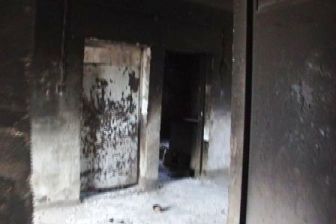
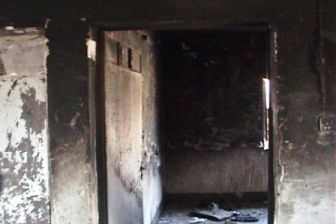
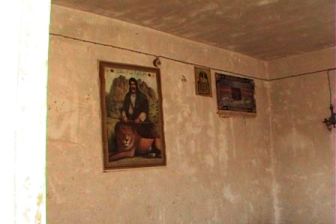
Nasser
village looked completely deserted. Nothing could be seen or heard except dogs’ barking. Most of the houses
were burnt out. We were filming the first, Hussein’s which was completely destroyed and burnt out
except for Imam Ali’s picture, when a young man, covered with dust, appeared from no where and asked
curiously what we were doing. He was very surprised to see journalists “at last” as he said, and began
relating what happened on November 5, 2005, the first day of Ramadan.
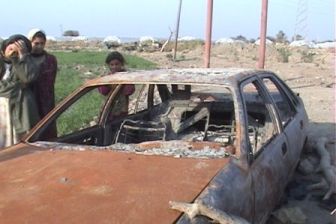 The
Iraqi police Special Forces, Al-Hussein Brigades, came at dawn. There were around 20 pick ups full of
them. They were hit on the highway very badly from a place behind the Yosfiya Water Project, east of the
village. Tens of them were killed. Their cars were burnt. Some of them hid inside the village. The battle
went on for 3 hours. In the end some of them managed to run away. In the afternoon, the same day, more forces
returned back accompanied by the American troops and helicopters. They evacuated their dead, raided the
houses, killed and arrested the men, humiliated the families, killed the cows and chicken, destroyed the
yards, and set the village on fire.
The
Iraqi police Special Forces, Al-Hussein Brigades, came at dawn. There were around 20 pick ups full of
them. They were hit on the highway very badly from a place behind the Yosfiya Water Project, east of the
village. Tens of them were killed. Their cars were burnt. Some of them hid inside the village. The battle
went on for 3 hours. In the end some of them managed to run away. In the afternoon, the same day, more forces
returned back accompanied by the American troops and helicopters. They evacuated their dead, raided the
houses, killed and arrested the men, humiliated the families, killed the cows and chicken, destroyed the
yards, and set the village on fire.
“They dragged one of the men Abbass Oeid, more than 70 years,
and beat him to death. Two other man, were arrested, Karim Motar, 50, and Riyadh Talab Jabr,
20. Their bodies were found three days later in Baghdad. They put police uniform on Karim’s body. Riyadh was
naked. Both were savagely tortured, their bones, backs, and arms were smashed”.
“They believed that the village was colluding with the resistance”.
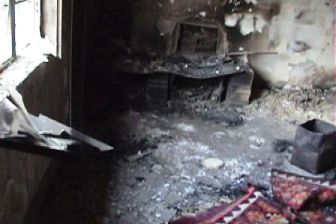
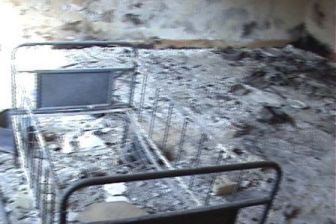
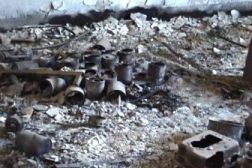
Ali Nasser, another man from the
village furiously denied that this is true “some of them were not killed, they managed to run away, they can
testify about what happened., actually they hid in our houses and fought from there, we gave them protection,
some families served them tea and bread. They say that the Sunnis are fighting them, we are Shiite, so why
they burnt our village?”
-
Can you answer this question?
-
“I can not, I do not know, that is why I ask the government to come here and investigate. We have done
nothing wrong, never hurt any body or broken any law. We were punished for a crime that we did not do. We
were in the middle of the fire, this is our only fault”
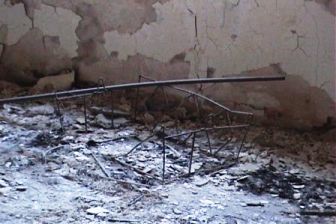
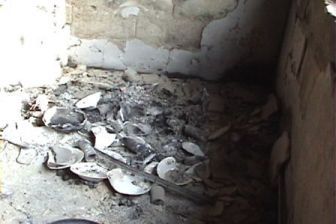
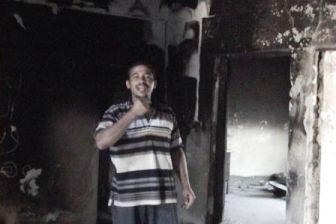
Ali’s house was completely
destroyed. The ceilings iron bars were dropping because of the fire. There were children beds, traditional
Iraqi babies’ swinging beds, babies’ milk cans, smashed plates, all burnt to skeleton. Ali was not hesitant
to talk in front of the camera.
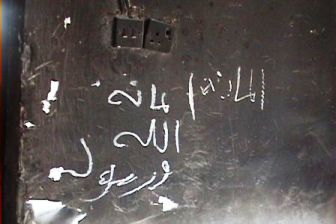 -“I
want the government to hear my question and answer me: why were we treated like this? The police brigades
broke even the electricity converters, we do not have power for 40 days, of course water pumps do not operate
and the plants are all dead. Our animals were killed, our women humiliated. They ask the women where did you
hide the men, they grabbed the children from their hair and throw them to the ground.
Riyadh’s mother was crying and begging them to leave her
son; they hit her with the gun’s end, they smashed his head with a brick in front of her eyes, now she is
dying. When his body was found it was skinned… Abbass was so old that he could not even walk, how he
would be a terrorist!! He was beaten to death on the spot and his body was thrown in the drainage. When they
searched the houses they did not find any indication that any of them had any thing to do with terrorism or
weapons, so why? The government is working on turning every body against it. It is encouraging ordinary
people to resist by treating them so savagely. They have no mercy. We have nothing left now, nothing”
-“I
want the government to hear my question and answer me: why were we treated like this? The police brigades
broke even the electricity converters, we do not have power for 40 days, of course water pumps do not operate
and the plants are all dead. Our animals were killed, our women humiliated. They ask the women where did you
hide the men, they grabbed the children from their hair and throw them to the ground.
Riyadh’s mother was crying and begging them to leave her
son; they hit her with the gun’s end, they smashed his head with a brick in front of her eyes, now she is
dying. When his body was found it was skinned… Abbass was so old that he could not even walk, how he
would be a terrorist!! He was beaten to death on the spot and his body was thrown in the drainage. When they
searched the houses they did not find any indication that any of them had any thing to do with terrorism or
weapons, so why? The government is working on turning every body against it. It is encouraging ordinary
people to resist by treating them so savagely. They have no mercy. We have nothing left now, nothing”
Ali went to the police with some men to complain. The police accused
the villagers of slaughtering the policemen. He tried to explain what he told us, that the village was caught
in the middle of the fires, that the policemen bodies were found in the village because they used it as a
shelter and were fighting there, that they were hit from the water project, but his attempts were useless. In
fact the police threatened to arrest him. 24 people were living in Ali’s house, now they are scattered on
five different places.
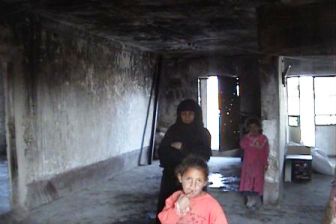
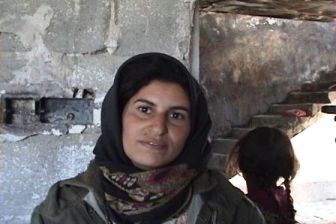
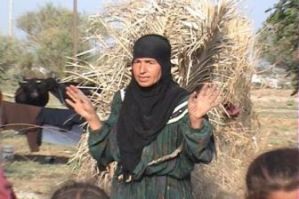
All Yosfiya men do not sleep in their houses, no matter if they were
young, old, armed, or have nothing to do with the resistance; because the police arrest any men around. Women
are left alone to face the situation. In Hilal’s house, deeper inside the farms we met Karima, a brave
farmer, Hilal’s wife and a mother of many children. Nothing was left in her small house, everything was burnt
out, even the flour, the sugar and the rice were destroyed.
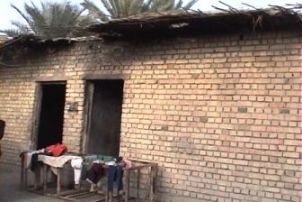 -“I
tried to save something, but I could not, they would not let me. They came in four helicopters and surrounded
the whole area. They put the gun on my head and asked where the mojahideen are. They destroyed
everything, even my medicines. They said you help the mojahideen with those medicines, and destroyed
them. Troops from the police Scorpion brigade were hit in the area the day before, and they believed that we
knew about the mojahideen”.
-“I
tried to save something, but I could not, they would not let me. They came in four helicopters and surrounded
the whole area. They put the gun on my head and asked where the mojahideen are. They destroyed
everything, even my medicines. They said you help the mojahideen with those medicines, and destroyed
them. Troops from the police Scorpion brigade were hit in the area the day before, and they believed that we
knew about the mojahideen”.
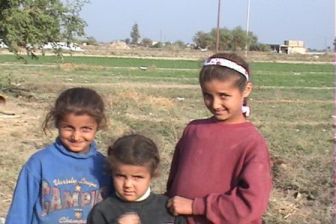
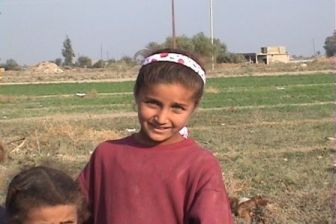
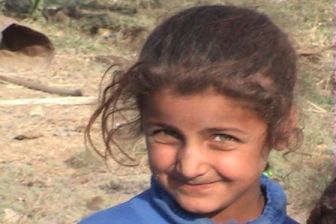
Three beautiful girls were looking at us and smiling. Ghofran was 10,
Iman 7, and Ayat, 5. They were the daughters of Hamid, Hilal’s brother, who was arrested almost two years
ago. “I could not see, he is in Bucca, they do not let me go to see him” Ghofran said pointing to her uncle.
Hamid was a school guard; he was arrested because the police believed that the school was used to hide some
kidnapped foreigners.
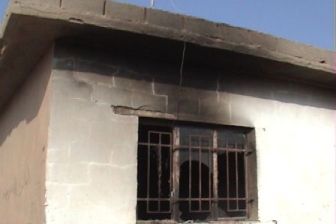
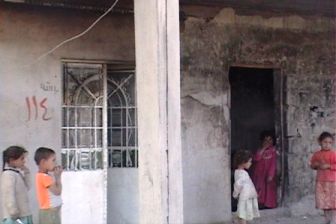
In Abid Ahmad house the same story was repeated. The police
forces were hit on the nearest paved road. They raided the house, destroyed the furniture, and burnt
everything, including all the family and the land documents. Worst of all they burnt Abid’s new car
which he just bought two months ago for 8 million dinars (more than $5000). Abid looks after a family of 18,
including his father, mother, sister and 2 brothers apart from his own children. “I have to pay 75.000 dinars
just to get them new IDs, you can imagine”
Abid went to the police to complain. The police and the judge decided
that he was innocent and deserved compensation “but frankly speaking, I do not have any hope that I will get
anything”.
Young Iraqi surgeon
testifies about the horrors of the Iraq war
‘Even during
operations, doctors were shot at by US soldiers’
Barbara Debusschere, De Morgen
(Belgium), 26 November 2005
translated 07 December 2005
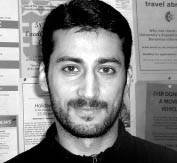 The
Iraqi surgeon Salam Ismael (29) has piles of pictures and interviews with survivors and witnesses that show
that many Iraqi civilians and doctors were victims of much more than ‘collateral damage’, as was the case
with the US attacks on Fallujah. “Doctors and patients were killed, ambulances were attacked. They used
illegal weapons such as napalm, and even those who surrendered and dared to move, were shot.”
The
Iraqi surgeon Salam Ismael (29) has piles of pictures and interviews with survivors and witnesses that show
that many Iraqi civilians and doctors were victims of much more than ‘collateral damage’, as was the case
with the US attacks on Fallujah. “Doctors and patients were killed, ambulances were attacked. They used
illegal weapons such as napalm, and even those who surrendered and dared to move, were shot.”
“I want to return to Iraq soon. In Fallujah, I’m going to help set up
a water purification plant, and in Hadeetha, I want to help build a new hospital”, Ismael says. It sounds
like urgent. A member of the Doctors for Iraq Society, Ismael is thin and has those typical long, fine
surgeon’s fingers. But in Iraq, Ismael has already survived the worst situations. His organisation is
gathering evidence of human rights violations under occupation. He was invited to Brussels by the Belgian NGO
‘Medical Aid for the Third World’, in order to draw attention to the war crimes being committed in Iraq.
Right before he would show his images to demonstrate that indeed
illegal chemical weapons had been used by the US during the second siege of Fallujah, Dr. Ismael finds the
time to tell his story. He doesn’t know where to start. But then comes an avalanche of stories, images, and
examples to underscore his point. “The breaches of medical neutrality must stop. Shooting at doctors and
ambulances is a crime.”
Were you yourself in those ambulances?
“Yes. After my studies in the Baghdad Medical School, I wanted to
specialise in orthopaedic surgery, but everything changed with the US invasion. Instead of pursuing my
studies, I offered my services as a volunteer doctor, and that is what I’m still doing today.
“It often happened that ambulances were shot at by US snipers, like
in Fallujah. During the first siege, one day we went to see an injured family. The Americans occupied the
street. We had to proceed just six meters in order to get to those people, but every time we tried to cross
the street, it rained bullets on the wall across. One of my colleagues finally dared to go. He counted to
three and, in his white coat, ran toward the wounded man, with the bullets flying. He took the man, folded
cardboard around his body and attached a rope to it. He threw us the rope, counted again to three, and we
pulled the patient toward us. Again, bullets drove into the wall.”
How did you work during the first siege of Fallujah, in April
2004?
“The Americans had cut the city’s access to the hospital, so we had
to set up a field hospital. Those were terrible days. We had to amputate legs with nothing but heavily
diluted local anaesthetics. We had to suture wounds with common thread and needles. During and right after
the fourth night, the night of the cluster bombs, we were no longer doctors, but gatherers of limbs. We
looked out for heads that could fit with other body parts. One man only had a collection of limbs as the last
remembrance of his wife and children. After two weeks a ceasefire was installed. But it was no real
ceasefire, as the snipers came into action. People were annihilated just like that, in the streets,
everywhere.”
Before the second siege, in November 2004, everyone was called upon
to leave the city. But even then, many civilians died.
“They always do that, they ask women and children to leave a city
before the attack. But that is sheer nonsense, as there are no provisions for them whatsoever. Many people
prefer to take shelter in their homes. But during the second attack, illegal weapons such as napalm were
used, killing people in their homes as well. And yet, whoever obeyed, would also be killed. (long silence)
“It is one of those catastrophes of which we have chilling
testimonies. A family of eight obeyed and left the city, toward the assembly point the Americans had
indicated. They walked one behind the other, with a white flag, hoping to quietly save their lives. But
suddenly, the Americans started to shoot at the families at the assembly point. A man who survived witnessed
his wife, his children and his father being shot, one after the other. He was injured himself, but after a
couple of hours he found the strength to wave for help. After which they shoot at him once more.”
What did you do during that second attack?
“I tried to help wherever I could. But during the second siege we
were not allowed to enter the city. Only later on we could. But yet, we tried to get to the people in need.
From inside the ambulance, we threw water containers and bread at them. Which immediately got riddled with
bullets. And that is only the most innocent example of the serious breaches of medical neutrality committed
by mainly the Americans and their allies. The Geneva Conventions state that the warring parties must respect
and protect medical personnel, and give them access to the patients. On their part, the doctors must be
neutral and treat any injured person. Well, we are accomplishing that task. I have treated Americans,
Iraqi’s, even insurgents.
“But many times, the soldiers attacked doctors and their patients, or
blocked and destroyed medical relief. Doctors were arrested while they were operating. ‘You are treating
insurgents’, the soldiers yelled. The patients were dying while the soldiers were beating up the doctors.”
Did hospitals get bombed?
“Yes. Snipers took the main hospital of Hadeetha, in the West, during
the US military operation Matador, on May 7. They knew that surgical operations were on-going. Doctors were
arrested, they blew the rooms to pieces, and even tanks entered the hospital. The entire medical stock was
destroyed, the warehouse burned for nine hours. I was working there, and we immediately started to
reconstruct the medical quarter, but on May 29, we were attacked again.”
Was there no serious suspicion that insurgents were hiding there?
“No, because the soldiers always search the hospitals, they search
every corner. And yet, it is illegal to sabotage operations and medical assistance, even if we would have
been treating an insurgent. Medical services in war zones are ridiculously senseless if you don’t have any
protection, if your hospital is bombed time and again, if your doctors are hit, if your ambulances are
attacked.”
Do only the Americans commit such violations?
“No. Also the Iraqi army and police, who have a lot of power. Some
time ago, they hit beat a doctor because he would not have treated a soldier well enough. As colleagues
started to protest, they, too, were maltreated. But in all the evidence we have been able to gather, and
which we intend to publish in a report, it is mainly the Americans who violate medical neutrality. Which is
logical, for it is their invasion.”
Can you always remain neutral yourselves?
“I am training young medical doctors, and I do that from the
perspective of medical neutrality. But as a doctor, that is not always easy. You are seeing people that have
been shot to pieces, and that makes you angry and defiant. I am not affiliated to any political party, but as
a medical doctor, I prefer the Iraq from before the invasion. At that time, at least we had the resources
needed to do our job. Now there is nothing, and even the most fundamental human rights are being violated.
Every day the Americans are creating more enemies by staying on, and by turning cities like Fallujah into one
huge prison, where people can only enter or leave through checkpoints. The waiting lines are long, and an
iris scan is required from everybody.”
How is the situation now?
“Concerning Fallujah, I don’t understand how they are able to
persevere that long. The city is a prison. There is hardly any reconstruction, many people are homeless and
are sick. In Baghdad there are now some medical facilities, but in the far-flung areas there are none.
Everything has been destroyed. Apart from the fact that we have received some new materials, the situation is
getting worse in the health centres. There’s an enormous brain drain. Doctors who have been targeted are
fleeing the country. All aid agencies have left Iraq as well. I launched an appeal at the World Health
Organisation. It is too bad that we have to beg like that, but we can no longer manage the situation.
“The biggest problem right now is the corruption. Donor money is not
reaching us, the entire administration is corrupt. There are no more taxes now, and the mafia is running all
kinds of trade, of medicines and food. Spoiled food is entering the country from Jordan and is being sold
freely in Iraq. There is no more supervision. Which renders even more people sick.”
Do you believe that the tension between Sunni and Shia may lead to
a civil war once the US withdraws?
“No, that is ridiculous. Only the mass media and the Americans are
saying this. Look, we have lived together for centuries. Sunni and Shia get married, have children, work
together. It is the politicians who are creating tension, in order to win seats. In real life there is
cooperation among common people. They do not experience the political ethnicity that is being fanned. And
yes, sometimes things get out of hand. But it is not the Americans who are going to solve that. No, they just
want to control everything, and they want to stay on. They are already building military bases for after the
retreat of their troops. But that way, every day they are creating more enemies, they are reaping more
hate.”
“White phosphorous? Last
year already we knew that the US killed civilians with it.”
One of the accusations
that Salam Ismael’s organisations, the Doctors for Iraq Society, wants to prove, is that the US has used
illegal weapons against civilians during the second siege of Fallujah. Ismael is hardly surprised by the
revelations on the Italian TV. “We have known all this for one year already. We have been able to gather
pictures from the South of the city, from the hardest hit areas. We have been able to analyse 77 corpses.
Even from afar, you could already notice that chemical incendiary weapons had been used against civilians.
Our claim is that white phosphorous was used in combination with napalm. If you mix napalm, which causes 4th
degree burns, with white phosphorous or magnesium, you create a burning effect of 3500°C. If that product
gets in touch with the body, it will burn away everything. That is exactly what we saw.
“Because of the war
against Iran, Iraqi doctors know the effects those instances can have on the human body very well. You will
indeed see clothes that are intact, but exposed body parts that are completely burned, that have
disappeared. Napalm sticks to the body, making it work even better. Moreover, it destroys the oxygen. We
also have images of people having died in their beds, at home, without any bullet wounds. Men, women,
children. They have a bluish aspect, or there is blood dripping from their mouths. Indications of the use of
instances such as napalm or white phosphorous.
“There have been other
indications, too. After the attack, aid workers were barred from entering the city for three days. Entire
areas had been levelled by bulldozers and covered with sand. Why? Look at our pictures, and you’ll know
why.”
Behind the Steel Curtain: The
Real Face of the Occupation
Dirty Means, Genocide and Mass Destruction
Dedicated to the UN, UNSC and the Intel Society
Foto
album of the devastated city of Al Qaim (18 Dec 2005)
Sabah Ali (18 December 2005)
 White flags on top of houses and cars, plenty of American and Iraqi
military vehicles, too many check points and blocks on the road, many frightening walking patrols, curfew
after sunset, heaps and heaps of destroyed houses, shops, offices, the only bridge, hospitals and medical
care centers, walls covered with bullets shots, and elections posters…empty faces with bleak looks wonder in
the streets. This is Al-Qaim picture after the Steel Curtain military operation which began on November 5,
2005 with 3000 thousands American and Iraqi troops participating in it.
White flags on top of houses and cars, plenty of American and Iraqi
military vehicles, too many check points and blocks on the road, many frightening walking patrols, curfew
after sunset, heaps and heaps of destroyed houses, shops, offices, the only bridge, hospitals and medical
care centers, walls covered with bullets shots, and elections posters…empty faces with bleak looks wonder in
the streets. This is Al-Qaim picture after the Steel Curtain military operation which began on November 5,
2005 with 3000 thousands American and Iraqi troops participating in it.
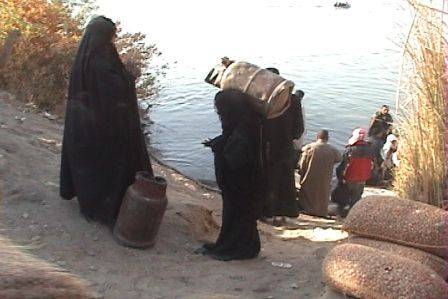 “You are filming our miserable condition so that Bush would pity us?!
You want to soften his heart?” asked a tiny skinny young villager disapprovingly, with obvious resignation.
She was holding a very heavy cooking gas tube, trying to climb the river bank. After the only bridge which
connects Rummana to AL-Qaim was severely bombed, citizens had to cross by boats.
“You are filming our miserable condition so that Bush would pity us?!
You want to soften his heart?” asked a tiny skinny young villager disapprovingly, with obvious resignation.
She was holding a very heavy cooking gas tube, trying to climb the river bank. After the only bridge which
connects Rummana to AL-Qaim was severely bombed, citizens had to cross by boats.
 Our driver was impatient with blocked roads, he takes the nearest
dusty detour whenever he saw a queue. We arrived Qaim around six pm; the darkness was already thick. Our car
was almost shot by the Americans, but the driver was very quick in going down the side road. “That’s how
families get killed” said Abu Adel, a lovable old man who asked for a lift, and who was very keen on showing
us his high education by using broken English phrases. Abu Adel was very angry because some Iraqis make use
of the refugees’ misfortune and ask for double or triple rents. He preferred to put his family in a hut
rather than being blackmailed.
Our driver was impatient with blocked roads, he takes the nearest
dusty detour whenever he saw a queue. We arrived Qaim around six pm; the darkness was already thick. Our car
was almost shot by the Americans, but the driver was very quick in going down the side road. “That’s how
families get killed” said Abu Adel, a lovable old man who asked for a lift, and who was very keen on showing
us his high education by using broken English phrases. Abu Adel was very angry because some Iraqis make use
of the refugees’ misfortune and ask for double or triple rents. He preferred to put his family in a hut
rather than being blackmailed.
Electricity is cut for more than a month now, after the main station
was bombed, and the converters were bombed and the wires were cut. In the morning Qaim looked horrible. The
General Hospital was 90% destroyed, the medical care centers, the schools, shops, houses…
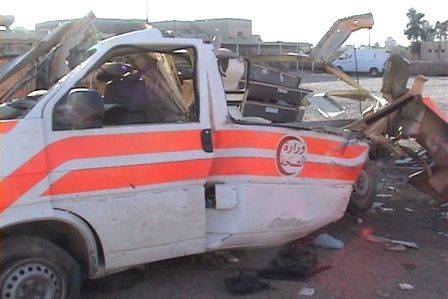 The Biggest Hospital in the Western Area:
The Biggest Hospital in the Western Area:
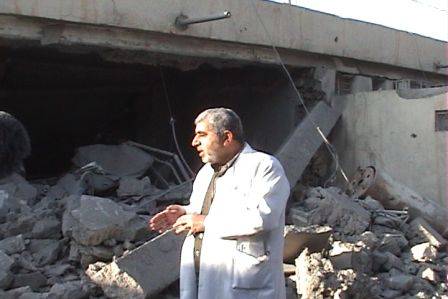 Dr. Hamdi Al-Aaloossy, the director came to meet us outside his
office, he canceled a meeting with the reconstruction committee “They are just ink on paper, those meetings”
he said. Dr. Hamdi is usually a very calm and considerate man. This time he was really sad and fed up. The
destruction this time was ultimate. He was repeating a line from a classical Arabic poem about how to
complete building while others destroy what is built. He showed us the gynecology, the pediatric, the
emergency departments, the blood bank, the new doctors’ house. All of them completely destroyed. “They were
hit by several missiles. Thanks heavens there was no one here, just a mentally retarded and epileptic
cleaning worker.” Dr Hamdi was especially sad about the gynecology dept. It was newly rebuilt in record
efforts and time, with the help of The German Red Cross. It was not opened yet. All the machines
Dr. Hamdi Al-Aaloossy, the director came to meet us outside his
office, he canceled a meeting with the reconstruction committee “They are just ink on paper, those meetings”
he said. Dr. Hamdi is usually a very calm and considerate man. This time he was really sad and fed up. The
destruction this time was ultimate. He was repeating a line from a classical Arabic poem about how to
complete building while others destroy what is built. He showed us the gynecology, the pediatric, the
emergency departments, the blood bank, the new doctors’ house. All of them completely destroyed. “They were
hit by several missiles. Thanks heavens there was no one here, just a mentally retarded and epileptic
cleaning worker.” Dr Hamdi was especially sad about the gynecology dept. It was newly rebuilt in record
efforts and time, with the help of The German Red Cross. It was not opened yet. All the machines
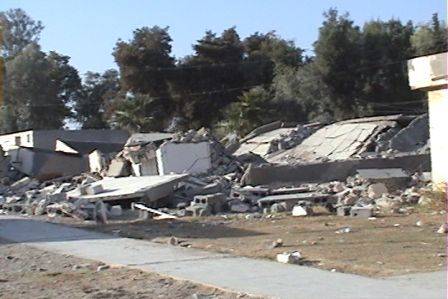 and
equipments were destroyed, even the ambulances in the hospital garage were bombed. They were empty. There
were 5 of them. Two were destroyed in the garage. A third was destroyed when the driver Mahmood Chiad Abid
tried to rescue a family in Karabla on October 1, 2005, killing him. The rest show obvious evidences of
shots.
and
equipments were destroyed, even the ambulances in the hospital garage were bombed. They were empty. There
were 5 of them. Two were destroyed in the garage. A third was destroyed when the driver Mahmood Chiad Abid
tried to rescue a family in Karabla on October 1, 2005, killing him. The rest show obvious evidences of
shots.
“But if the hospital was empty, why was it bombed? Usually the
Americans say that there were terrorists inside?!”
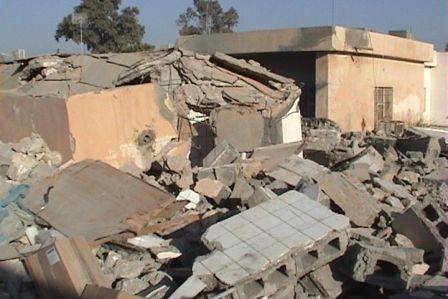 “I assure you that not a single body was found under the rubbles,
neither any injured person. They attacked the hospital on Nov 7, two days after the major attack on Qaim.
There was no patient, no staff, and no armed men. There was one doctor, however, who decided to stay in the
hospital. But during the bombing she hid in a neighboring house. 90% of the hospital was destroyed. I call
upon the Health Ministry, the Iraqi Government, the Iraqi and international organizations to help us rebuild
whatever we can. Of course the departments which are bombed are beyond repair, as you see, they have to be
built anew, but we can rehabilitate the other ones. The HM did not send any delegation to see the damage and
estimate the expenses. It is more than a month now, and the hospital is still working”.
“I assure you that not a single body was found under the rubbles,
neither any injured person. They attacked the hospital on Nov 7, two days after the major attack on Qaim.
There was no patient, no staff, and no armed men. There was one doctor, however, who decided to stay in the
hospital. But during the bombing she hid in a neighboring house. 90% of the hospital was destroyed. I call
upon the Health Ministry, the Iraqi Government, the Iraqi and international organizations to help us rebuild
whatever we can. Of course the departments which are bombed are beyond repair, as you see, they have to be
built anew, but we can rehabilitate the other ones. The HM did not send any delegation to see the damage and
estimate the expenses. It is more than a month now, and the hospital is still working”.
Al-Qaim general hospital is one of the most important hospitals in
the far western area of Iraq. It covers the whole area from Haditha to the borders, where there are hundreds
small towns and villages. There are several medical care units connected to it. In Haditha there is a similar
general hospital that covers the area from Haditha city beyond till Ramadi. Both hospitals are now severely
damaged and burnt.
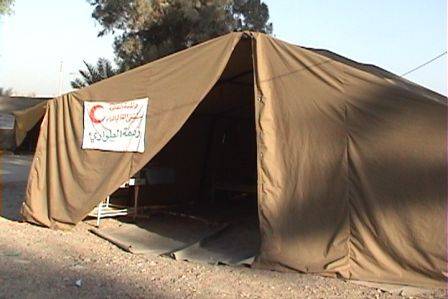
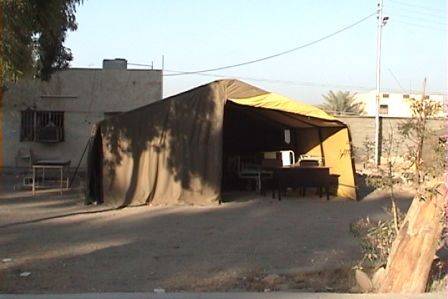 Dr. Hamdi put 5 big tents for the medical, pediatric, and emergency
consultation departments in the hospital’s garden. The other ones are for medicine and furniture store. A
small bare room was used as labor room (where there were no equipments whatsoever to examine the mother or
the baby, just two beds). We attended an emergency operation. The operation theater’s windows, walls, and
doors were broken, but the staff did their best to keep everything clean and sterilized. Everything went
well. “You are heroes” I said. “No, just doing our best” the doctor replied.
Dr. Hamdi put 5 big tents for the medical, pediatric, and emergency
consultation departments in the hospital’s garden. The other ones are for medicine and furniture store. A
small bare room was used as labor room (where there were no equipments whatsoever to examine the mother or
the baby, just two beds). We attended an emergency operation. The operation theater’s windows, walls, and
doors were broken, but the staff did their best to keep everything clean and sterilized. Everything went
well. “You are heroes” I said. “No, just doing our best” the doctor replied.
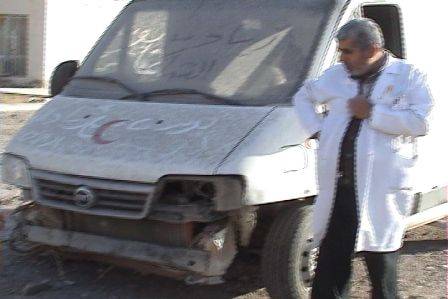
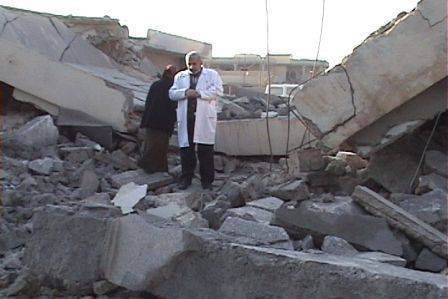
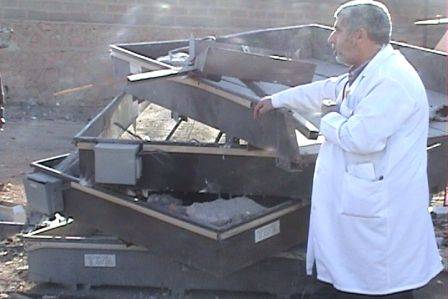
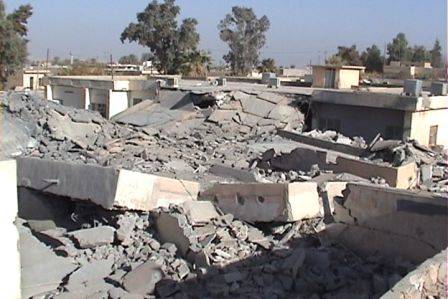
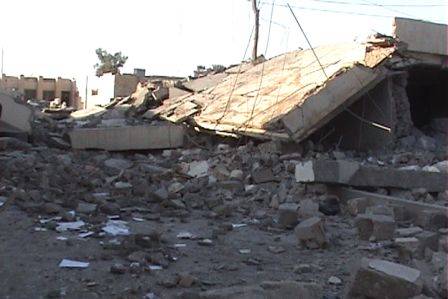
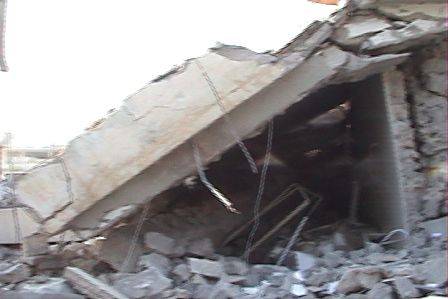
But they were heroes, to work in such conditions. Many of the medical
staff donated blood to patients and went back to work immediately. They have severe shortage in oxygen tubes,
so they rationed it to be used only in emergency operations. They have no more than ten tubes. “With people
like you, there is always hope” we said. Dr. Hamdi smiled “We never lose hope”. No media coverage was present
to show Al-Qaim tragedy.
A Family of 17 killed in few seconds
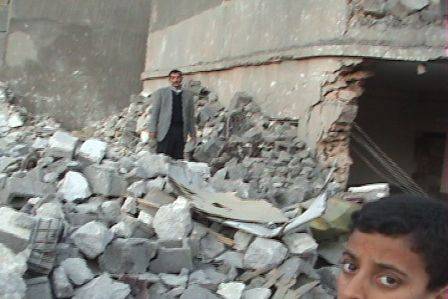
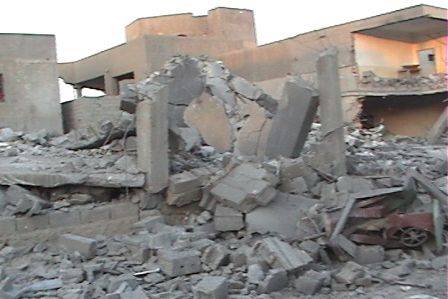
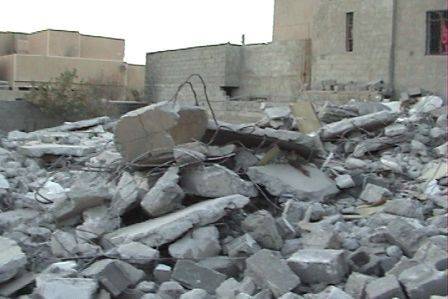
Modhhir Najim Abdulla, a security officer in the hospital took us to
his uncle’s bombed house where 17 women, children, and civilians were killed. The house of Arkan was just
heaps of concrete blocks; the roof was flattened to the ground. There were 5 families living there. Not one
of them was a stranger or a fighter.
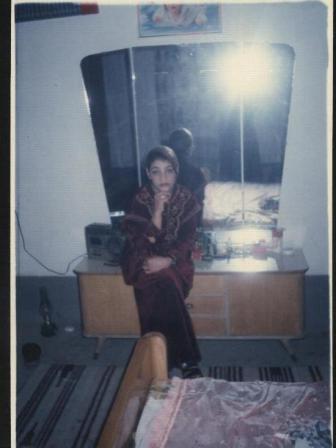
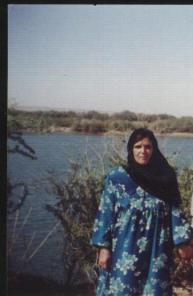 “I just want to know why, I want a justification” Modhhir began, “the
bombing began on Nov 5, loud speakers were saying stay at home, do not move out, and we did. 15 minutes later
the bombing began. They did not announce evacuation. We had no chance to leave”. On Nov 7, we heard that our
uncle’s house was bombed. We could not go to check; we went to the nearest American troops and told them.
They accompanied us, and this is what we found
“I just want to know why, I want a justification” Modhhir began, “the
bombing began on Nov 5, loud speakers were saying stay at home, do not move out, and we did. 15 minutes later
the bombing began. They did not announce evacuation. We had no chance to leave”. On Nov 7, we heard that our
uncle’s house was bombed. We could not go to check; we went to the nearest American troops and told them.
They accompanied us, and this is what we found
Modhhir was not crying, but his voice was full of rage. His sister (Najla’)who
was the wife of his cousin too, was pregnant in her 9th month. She was supposed to have cesarean
operation because she was a week late for her due time. “I can not describe her and her baby when we removed
the bodies”. Another cousin’s baby was only 25 days. A third child’s body was not found until 2 days later.
Modhhir brought the family’s IDs, death certificates, and photos.
They are (name, age, relation to Arkan and cause of death)
Arkan Abdulla Family:
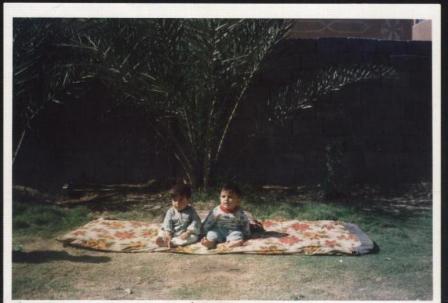
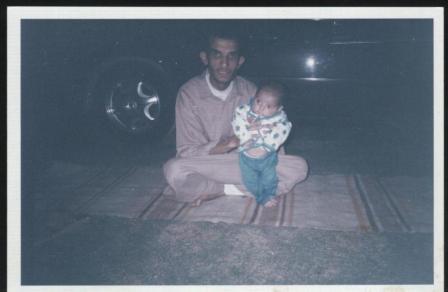
1-Alia Amir, 50, wife, smashed scull, broken ribs, burns and injuries
in the chest and abdomen
2- Asma’a Arkan, 23, daughter, suffocation
3- In’am Arkan, 14, daughter, smashed scull
4- Lubna Arkan, 12, daughter, injury in the head and suffocation
5- Abdul Razzaq Arkan, 10, son, broken ribs and suffocation
6- Mahmood Arkan, 22, son, broken scull and suffocation
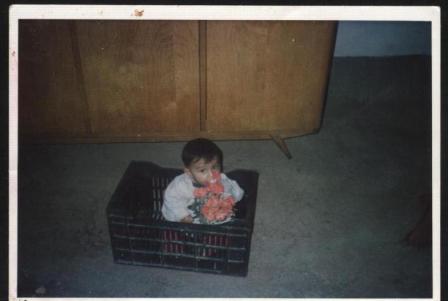 Saddam Arkan Abdulla Family
Saddam Arkan Abdulla Family
7- Khatar Dahham, 28, daughter in law, injuries and broken scull
8- Dhuha S. Arkan, 10, grand daughter, broken scull and injuries in
head
9- Abdulla S. Arkan, 9, grandson, intestine tear
10-Thammir S.Arkan, 4, grandson, broken ribs, bleeding inside chest
and broken legs
11- Amir S. Arkan, 7, grandson, smashed scull, suffocation and
legs injury
12- Yahia S. Arkan, 3, grandson, smashed scull
13- Saja S. Arkan, 2, grand daughter, smashed scull, tissue tear
and broken ribs
Fanar Arkan Abdulla Family
Asma'%20(forth),%20Saja%20(sixth),%20In'am(last).jpg)
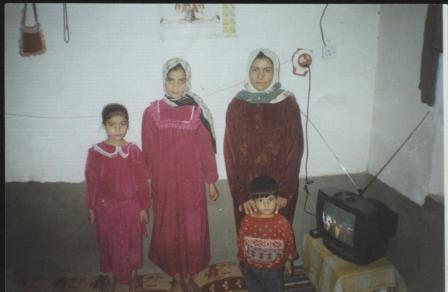 14- Najla’a Najim, 22, daughter in law, smashed scull, suffocation
14- Najla’a Najim, 22, daughter in law, smashed scull, suffocation
15- Leila Fanar Arkan, fetus, given birth and death certificate at
the same time
16- Ahmad Salih Amir, 25 days, nephew, injuries in head, chest and
ribs.
17- Khattab Mahmood Arkan, 2, grandson, smashed scull
“Who of these do you recognize as terrorist? this one, this, or may
be this”. The pictures were of women in a party, many children in different occasions…This is my sister, this
is her son, this is my youngest cousin….etc. He was pointing to the faces and naming them. I felt that the
list was endless. “Please stop”, I said.
“Why do you think your uncle’s house was bombed?” I asked
“I do not know. I want them to answer this question. They bombed
three houses in this street. In the other one 7 children and women were killed. It is Fuad’s house, there.
The third one was empty, but it is no more than ruins. You can see it. May be they had wrong information
about these houses, I do not know, may be they made a mistake…but these are not excuses. Even the American
soldiers, the Iraqis, the CNN reporter were crying when they saw what happened to my family”. The family was
buried in the garden.
The American troops played a classical, colonial, very dirty trick of
divide and conquer in Al-Qaim. They allied with one big tribe, Al bu Mahal, against another very big one, Al-Salman.
They used one as informants against the other. These people may make mistakes, or they may give wrong
information for different reasons, but innocents get killed in the process. In the last “Steal Curtain”
operation, thousands were arrested, and informants from the other tribe were used to pick those who were
thought to be insurgents. This story was repeated in many places: Rumanna, Karabla, and Al-Ebeidy. Of course
any one who is branded as a collaborator (traitor) is killed. Qaim is one example of what is happening in
different parts of Iraq.
Faud’s house was just across a dusty yard. Again it was no more than
scattered bricks and cement blocks. Nassir, a cousin was called to describe what happened.
“We did not know, only by chance. Our house was raided, I was upset
and decided to visit my uncle Faud’s house. The whole area was empty, only the American troops were filling
the place. When I approached the house, it was as you see it now. I heard the voice my cousin Salaam and, and
his sister Anwar calling for help. They were injured. But other 7 were killed. Cousin Isam (35), his wife
(25), his children Hani (7) and Reem(3),his sister (20), Salaam’s bride, Sheima’ (20), and Quteiba were all
killed.
The stories of buried families under the rubbles became familiar in
Qaim. In Mohssin Mohammad’s house, near the electricity station, a family of 20 were killed, and in Mohssin
Hommadi‘s house 35 were killed, we were told… “We used the food refrigerator to put the human bodies”, A., an
employee in the hospital said.
A. did not leave Qaim during the last attack. He described what
happened.
“On Nov 5, at 3 am the troops were dropped in the Railway and the
Saray areas. At the same time, the bombing never stopped. Electricity was cut, and water too. The bombing was
random. The tanks dashed in the street savagely. They bombed everything, even a small door. We were two
families staying in the whole street. My gate was already broken because of the bombing. I crawled to open
the inner doors. They were about 40 when they raided my house. They asked about terrorists and weapons. They
searched the house, and found nothing. They were attacked while they were in my house. In 6 minutes 3 houses
were destroyed in retaliation. They told us to close our ears and open our mouths when they bomb. A
journalist accompanying them operated my generator and began to send his story from my house. They dug
trenches in the neighboring Hadg Thammer house, opened big holes in the walls, and ruined the roof”
AM, another employee from Rummana said “we saw 14 Chinook airplanes
bombing, we heard that there is a major attack on Huseiba. 5 days later we heard that the attack was on
Karabla and Ebeidy which was hit by %50 missiles from dawn to sunrise at 6 am. A man said that they used
white phosphorus
“how did he know that?”
“He said that when the dead were buried, their clothes were intact,
but the bodies were like ashes when they were held. In Rummana they collected all the men, and the Iraqis who
accompanied them would point to some who are then taken away. The troops are still occupying the schools and
the medical center. They tell the families to leave then they blast the house. They did that with 15 houses
in Rummana. In one month, at least 150 were killed in Rummana. On Nov 15, they forced the families to spend
the night outside in Ebeidy. Two newly born babies died in the cold”.


Next day we tried to go to Rummana . It was worse than AM described.
The bridge, was bombed twice. First, no cars were able to cross, only on foot. Then, it was bombed again in
three pieces, which raise their heads from the Euphrates as eternal witness of the American colonial
barbarism.
Inside
Iraq's secret prisons: an Iraqi testimony.
Salam Al Jubouri (BRussells
Tribunal) 2005-12-19
The White
House seemed very upset with what happened in the Green zone, when US soldiers “found” the jail of Jadriya
while they were looking for a 15 years old kidnapped child. The images of torture and execution disturbed
the US government, who now claims to be the champion of human rights and democracy. Even Condolencia Rice
proclaimed that “the US does not torture”. They pretended that the Jafaari government had let them down with
such abuses. How hypocrite can you get? They trained these men, spent 3,3 billion $ out of the 2004
Pentagon’s 87 billion $ budget to create and fund militia’s like the Badr militia’s and the Wolf brigade.
They don’t fool no Iraqis, even when they hire people like Christian Bailey to plant false stories in Iraqi
newspapers. We Iraqis know what’s happening. The US bears prime responsibility for the torture and killing of
Iraqi civilians. They transferred their dirty methods used in Nicaragua, El Salvador, Honduras and Guatemala
to Iraq. And they kill without remorse, using their militia’s to carry out the torture for them. They must
be very desperate. On the one hand they want to invade Iran, on the other hand they fund and train Iranian
militia’s, and support Iranian fundamentalist currents. But when they decide to invade Iran, every single
Shia in Iraq will join the resistance. And they will be as ruthless against US forces as they are now against
the Iraqi resistance. How can the US ever get out of this quagmire? A good advice: the sooner they leave, the
better for them
My story is
about those jails far away from the Green Zone, near to the Iranian zone. Who feels the pain of the prisoners
under the whips of the Iranian investigators in Medain, Kut, Baladiyat, and Hilla ? And what is the role of
the UN as independent international organization in Iraq, when “investigators” in Iranian jails in Iraq shoot
people down without reason, and the UN is looking the other way
My friend
Majed Hadi al-jubourie, 27 years old, was arrested in October 2005 by Al Rafidain forces, with the support of
US troops, and he and his 3 brothers and 55 years old uncle were taken to the Al-Rafidain forces headquarters
in Baladiyat, south east of Baghdad near to the formal Security building
“From the
first moment when we were arrested, I felt that those soldiers who arrested us were not Iraqis, I mean they
were really very close with Iranians, that was clear through their accents, and through the sayings and the
singing that are typical for the Badr forces and the dead Hakim”, Majed said
Majed
thought that he and his brothers would be executed, because incidents of arrests by the police, who execute
people before throwing their bodies in isolated areas, is a common practice these days in Iraq.
“They
blindfolded us, handcuffed us and put us in an American van without windows, to the Al-Rafidain forces camp,
then they put us in a cell and started their investigation which consisted only of beatings. They did not ask
us a specific question, they did not know why we were there, all they knew was that ‘we are Sunni’s and we
are men’”, Majed said angrily. “They used sticks and pipes to hit us, every night. We were trying to cover my
uncle because he is sick and older than us. We thought that he might die under these severe beatings”
Majed
considered himself lucky at that time, as he was hearing the sounds of torture in investigations rooms and
solitary rooms, he was hearing the shouting of the prisoners, and he saw them after the investigation: half
dead. They brought them with blankets as they were not able to walk
“They were
torturing people from the Dora district. They were so savage with them, so brutal. They were torturing them
many times a day. One day they were torturing us after dinner, and they decided to put us with them in the
same cell. We were forty people, squeezed in a tiny cell. These were the most difficult days. I thought that
I would die. They broke my bones, they tortured me and everyone in that cell, to force us to confess that we
killed policemen, and tried to make us confess in front of a camera to show us on Al-Iraqia tv”
“They
ordered my brother Hamed to carry dead bodies from people tortured to death. They choose him because he was
big and strong. I thought that they would kill him later on as he saw a lot of their crimes “
Hamed is
still afraid of the horrors he witnessed. He asked me not to mention anything that would reveal his identity,
and he decided not to stay at home after that horrible experience
“They were
killing people as if they were killing flies. They were not afraid of anything. It was apparently very easy
for them to kill anyone. I carried many bodies which were covered with blood and filled with holes of
drilling devices, and some of those bodies were shot. They gave me this job for one reason: they did not
want their uniform to be covered with blood. We were putting the bodies in ambulances, and then they would
take them away. I think they were thrown into rivers or in deserted areas”
Hamed told
me: “the ground was covered with blood, all red. They used everything to torture people. Making holes in
heads seems to be very easy for them, as they were trained to do that. They do a dirty duty and follow orders
from superiors”
Majed told
me about someone's horrible painful story inside the jail. This story is a good example of how terrible and
inhuman the people are that were in charge of the jail. “They took someone for investigation and we were
hearing him shouting during the torture. They were telling him to confess what he did. He was saying that he
did nothing, then they shot in his leg with a pistol, then brought him back into the cell. He was bleeding a
lot, because there was a hole in his leg. We treated him with a rag and we asked the guards to take him to
hospital, but they refused, they said: ‘you Sunni’s deserve this, you are Saddam's people’. The man was
dying and no one could help, they kept him for more than a week until there was a bad smell coming from his
leg, we all were smelling. The place was incredibly dirty with urine and human excrements. I still feel the
smell coming from that man's leg. It was like he was rotting. He remained there when we were released. He
asked us to inform his family in case he would die, and said: “pray for me. I want to die, because I can’t
stand the pain anymore”
Majed
said: “if you get out of that jail you feel a desire to join Zarqawi’s people to fight against the Shia and
Americans, and you believe what Zarqawi says, if he exists. Those militia men were hanging Hakim’s picture
everywhere in the jail and tortured us continuously. I hate that picture now. I hate their black hats and
their dirty beards. They are a shame for Islam. They are not Muslims”
Majed said
that some Shiite religious men were mediating between the prison officers and the prisoners families. Their
families had to pay something like $3000 to release a person, sometimes more, depending on the financial
situation of the prisoners families
This
is now happening in Iraq, to my friends and family, on a daily basis, while you Americans are buying
Christmas presents and preparing Turkey. Every Iraqi has a similar story to tell. We never had sectarian
violence before, but Bremer and Bush are successfully heading for a catastrophe when they remain in Iraq. And
I’ll tell you why. Let the occupation troops leave and the equilibrium will be restored. Now people can kill
without impunity, because they feel protected by the occupation forces. They are pushed into a sectarian
corner by every law that has been issued by Bremer and the TAL. But if the troops leave and one Iraqi kills
another Iraqi, he’s certain that there will be revenge. Remember that this is a tribal society, and if one
member of the tribe gets killed, the other members of the tribe have the obligation to revenge this killing.
Everyone in Iraq knows this, and they will think twice before committing atrocities as they are doing now,
with the help of US tax money and protected by Bremer’s laws and US occupation forces. I hope you understand
by now that there is only one way to solve this conflict before it really escalates: bring your troops home
before my people kicks them out. With every new prisoner, every new civilian killed by your airplanes and
Apache helicopters, ten new people will join the popular resistance
Attending a Human Rights Meeting!!
or
One Morning in Baghdad...
Sabah Ali
January 4, 2006
Human rights meetings are always interesting to me, no matter what.
Just to show up in such meetings is support to people who desperately need it. There are millions of them in
Iraq nowadays. That's why I decided to go to Falloja to attend one of these meeting although I was invited on
a short notice.
As usual, no taxi driver was willing to take me to Karkh
(western side of Baghdad), where the Alawy car station is. The streets are jammed, they say. It was 8;
I need to be in the station at 8.30 at least. I told the forth taxi driver that I would pay whatever he asks.
Less than three minutes later, we were at Al-Tahrir Square. Al-Jumhooriya Bridge was blocked by
the American vehicles. In the next square, Sinak, a minute away, the Sinak Bridge was closed
too. The square was a lake of stagnant cars. There were hundreds of young and old people, men and women,
crossing the bridge on feet. Tens of police and military vehicles were jammed with policemen and soldiers,
pointing their guns in different directions, blocking the roads and bridges, more than the usual. I decided to
cross the river on feet. The driver took 3000 dinars (more than 2 dollars). The transportations fees doubled
or tripled after the latest rise in the fuel prices.
I asked one of the policemen in a pickup, he was smoking absent
mindedly, what was going on. "I do not know" he replied with a shrug of his shoulders, puffing out the smoke.
"Is there any explosion?" I asked again. "No!" He was sure.
Climbing the bridge, even on feet, was not an easy matter. The
barbed wires left small space to pass, and going through pointed guns was not a comfortable experience. A fat
women in her fifties was cursing and breathing with difficulty. Two American hummers came from the opposite
direction, where the green zone is, followed by a black-windows car and three other hummers.
"That's why they are blocking the roads" the fat woman said "they
are protecting their masters". She was sweating and putting her hand on her chest. "Are you alright? Do need
help?" I asked. She was leaning on the bridge fence, facing the river. "It's my heart" she replied
breathlessly. On the right, in the Ahrar bridge direction, a huge cloud of black smoke was going up.
So, there is an explosion after all.
The middle of the bridge was cut by more barbed wires and different
police cars and trucks again. Some of the police men were taking the firing position on the ground. Some men
were arguing with an officer who was trying to explain some thing.
"These are the regulations" he was repeating "we are not in normal
conditions, the Interior Minister's sister is kidnapped as you know, and there is a big military and police
search operation going on today". The men were interested enough to discuss how futile the operation and the
technique are.
A woman in a black leather coat, with long brown ponytail, was
discussing the salaries and pensions with two young men, before me. She sounded strong and well-informed. I
felt happy to see an Iraqi woman, different from the gloomy stereotype drawn for Iraqi women nowadays. But the
voice was familiar. Passing by them, I recognized her. She is a painter or a sculptor, known for stealing
paintings and works of art from the Modern Arts Museum after the invasion of Baghdad in April 9, 2003.
The roads on the opposite side of the bridge were also closed. There
were no cars, only the military. To go to the Alaway station I had to walk all the way from the Information
Ministry old building, the April 28 area, the Green Zone, the ministry of Foreign affairs,
the head quarters of the Kurdistani Democratic Union, only to find out that the station was closed.
Needless to say, all the roads were closed. Police cars, sirens, bullets, guns, shouts and the American
vehicles were filling the atmosphere. People were not allowed to go out or in the station. For some reason a
policeman waved to the garage busses which were waiting for too long, to go out. The rush was crazy. Another
policeman ran very quickly in the garage gate direction, shooting bullets in the air and shouting "inside, all
the cars inside..." The people were very angry "why are you arresting us here? We have to leave…etc". The
shouting became mad. The police man was firm. NO car moves. The people, cursing everything and everybody began
to leave the cars, the busses and the garage.
"I have to go to Falluja" I replied to a student who was
asking how to go to the university.
"If you manage to reach Amriya, there are cars there which go
directly to Falluja"
It was already 10. The meeting was at 11. I do not know how long it
would take to reach Amriya, if at all. I needed a plan. My strategy now is to reach a place where I can
get a taxi to Amriya. I walked away from the station towards the road that leads to the highway. The
road was closed.
"Do not go through Mansoor, Yarmook, or Qadissiya" a
policeman said "those areas are all closed even to pedestrians". The Interior Minster's sister was kidnapped
in Qadissiya.
I walked towards the Iraqi National Museum. There was a big banner
with Al-Hakeem's (the head of the Supreme Council of the Islamic Revolution party) picture hanging above a big
poorly repaired hole in the Museum entrance arch created by a grenade during the American invasion of Baghdad.
Many other banners were hanging on the destroyed statue in the Museum square. People were gathering, looking
for any transportation. A police car approached "Do not gather here it is dangerous, move" one of them was
shouting. We headed towards the Ahrar Bridge. I decided to take the first car any where to get out of
this trap.
A mini bus was calling "Kadhimiya". I jumped inside. "I want
to go to Amriya, please take me to the nearest place where I can get a taxi. He asked for a doubled
fee.
The few streets left were drowned in floods of endless car queues.
"Why did not they announce a curfew" was a question on every one's tongue. Haifa street was blocked
with giant trucks carrying new big cement blocks to close or limit more streets.
"They are going to distribute these blocks on families free of
charge" said the driver sarcastically. "I heard that they are going to give them to the families instead of
the monthly food ration" replied one of the passengers, laughing. The Trade Ministry has just announced that
the food ration is going to be reduced.
Buratha Mosque, one of the old Shiite mosques in Baghdad was being
restored and enlarged. The street again was blocked with hills of sand, bricks, construction equipments …etc.
Aden Square
is the best point to go to Amriya. "You have to pay 6000" the taxi driver said. It was 11.10. The high
way was mysteriously open, but our car was the only civilian car on the road. A very big American convoy was
coming from the opposite side, and many Iraqi military vehicles and American helicopters were patrolling the
way. There were Iraqi walking pattrols in Ghazaliya too. The driver was afraid and began to grumble "I
never come to this terrorists' area, the devil tempted me this time". Shooting began. Many gun shots, very
near. We hid our heads in our laps instinctively. The driver took the nearest opening in the highway.
Obviously, they were warning us. At the Amriya fuel station, kilometers of car queues were waiting.
There was no fuel in the station, but the cars were waiting just in case the tank comes. After the latest
5-double rise in the oil prices, few could buy it in the black market.
In the Falluja car at last, but the high way was closed. We had to
take a detour through Shu'la, a village north of Baghdad, close to Kadhimiya, ironically. But Shu'la check
point was also closed and we had to take another detour through a dusty, deserted and dangerous road. An hour
later we were again on the highway, only 5 minutes west of Amriya.
Falluja, by the way, is normally no more than 30 minutes west of
Baghdad. When I entered the meeting room, it was almost 1pm. The meeting was held in a school, with students,
classes and everything. The meeting was ending. A man was talking passionately about the oil problem, the
corruption and the missing men in jails. His voice collapsed and he broke into tears. Another man ended the
meeting by talking about 1200 families who raised a complain against Ayad Allawy (the previous prime
minister) for killing their loved ones. The case was closed by Jafari (the current prime minister)
government. "Do not you see" he concluded "No one would help; every one has to take care of his own
problems".
It was 5 pm when we arrived back in Baghdad. The traffic jam was
lesser now. On the radio, the Interior Minister's sister story was on the news. I felt relieved. "Now he is
going to feel the agony of people" I caught myself saying. Suddenly, I realized that I was supporting an act
of terrorism, of kidnapping a woman, a thing that I condemned all my life, and still do. In the evening, Al-Sharqiya
satellite channel put a program on what happened in the morning, the blocked streets and bridges, the angry
people, the fuel queues … I was relieved again. But noting was mentioned about the human rights meeting.
ps. Baghdad streets, and Iraq highways, are private properties
now of the American troops. to pass, you need their permission, which is not easy at all.
Death Squads and
Iraqi police: two sides of the same coin.
Dirk Adriaensens (BRussells
Tribunal) and Isam Rasheed (Baghdad) 03 March 2006
“Faik Bakir, the director of the Baghdad
morgue, has fled Iraq in fear of his life after reporting that more than 7,000 people have been killed by
death squads in recent months, the outgoing head of the UN human rights office in Iraq has disclosed.”
(…)“Mr Pace
[UN official] said records, supported by photographs, came from
Baghdad's forensic institute, which passed
them to the UN. The Baghdad morgue has been receiving 700 or more bodies a month. The figures peaked at 1,100
last July - many showing signs of torture.”
(…) “Some militias are integrated with the
police and wear police uniforms," he said. "The Badr brigade [Sciri's armed wing] are in the police and are
mainly the ones doing the killing. They're the most notorious." Jonathan Steele
www.guardian.co.uk/Iraq/Story/0,,1721366,00.html
The BRussells
Tribunal recently received evidence of 2 such cases, where the Iraqi police was clearly involved in “Death
Squad” activities. Acting under the protection of the Ministry of Interior and the Industry Ministry, they
are
unscrupulous torturers and killers. We had
doubts about publishing the story, because the pictures are very disturbing. But keeping Robert Fisks’ words
in mind: “if the mainstream media would publish photos of the real war, as I’ve seen it, nobody would
support this war”, we decide to make these cases public.
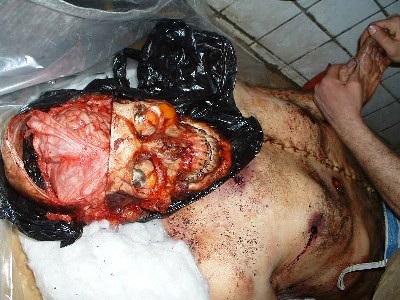
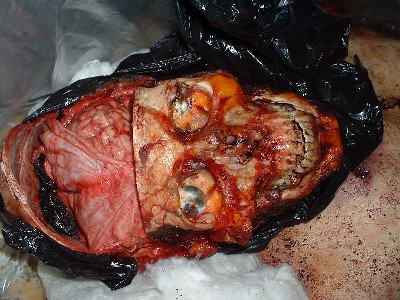
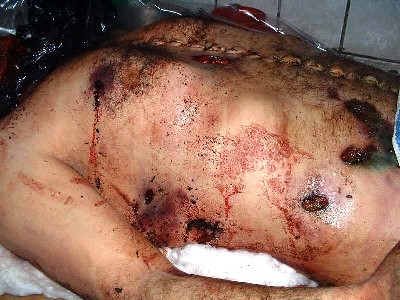
1- His name was Khalid Waleed Ahmed. He was Sunni,36 years old, married and having three kids, the youngest one was only
4 months years old. He was an engineer, working for a private company, and he lived in the Ur area in
Baghdad.
Thursday 23 February 2006 at 6:00 pm when he was having dinner, his house was raided by several men dressed
in black. They came with many cars, and some of these cars were from the Iraqi police (as his brother said).
They arrested him and also broke all the doors of his house. After three days they found him in the morgue in
Baghdad.
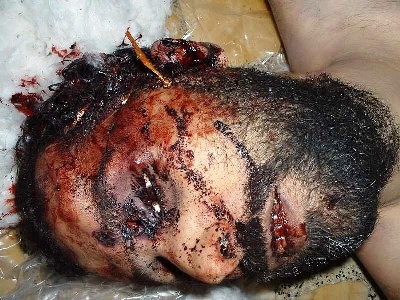
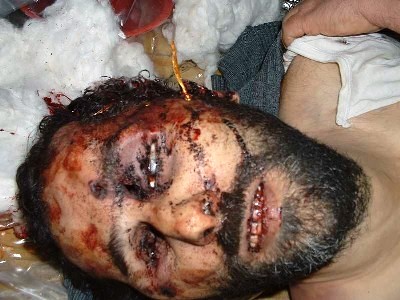
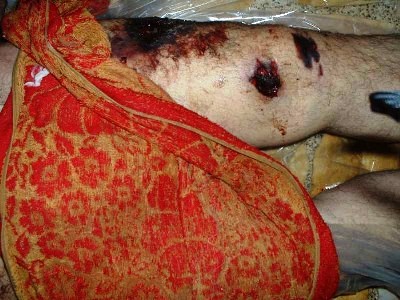
2- His name was Wa'ad Jajim Mohammed, Sunni, 46 years old, married and having three kids. He lived in the Cairo area in
Baghdad. he got arrested on Saturday 25 February 2006 in his house at 4:45 am. His family found his dead body
in the morgue after two days.
Militants of Jafaari commit
massacre in Al-Fursan village. US sponsored death squads in action.
Haythem Khatab, Dirk Adriaensens (BRussells Tribunal) 23 March 2006
Photos: Haythem
Khatab
Immediately after the
blast in Samarra targeting the shrines of Ali Al-Hadi and Hassan Al-Askari, men dressed in black, and in large
number, attacked Sunni mosques and areas. In some attacks, cars of the Ministry of Interior were used; like
the attack on the mosque of Fandi Al-Kubaisi in west Baghdad where 14 police commandos were killed when
citizens of Al-Shurta district defended their mosque.
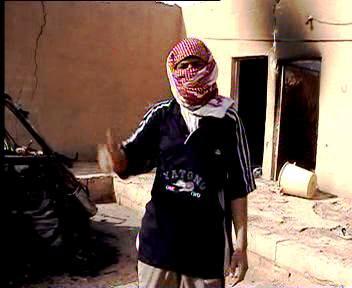 Black-clad
militias and police commandos also attacked Al-Fursan (bani ziyad), a little Sunni village located in
Nahrawan, south east of Baghdad. I decided to go there to film when I heard that some from the Iraqi Red
Crescent would visit the village and bring aid 03 March 2006. I went with two ambulances and a truck carrying
lanterns, kerosene, blankets, etc. I was sitting in the second ambulance and trying to film the road when a
man from the Red Crescent advised me not to given the checkpoints along the way, and as civilian spies were a
danger also. I filmed four police cars burnt out on the road. There was a cameraman from the Baghdad office
of the Iraqi Islamic Party TV channel with us.
Black-clad
militias and police commandos also attacked Al-Fursan (bani ziyad), a little Sunni village located in
Nahrawan, south east of Baghdad. I decided to go there to film when I heard that some from the Iraqi Red
Crescent would visit the village and bring aid 03 March 2006. I went with two ambulances and a truck carrying
lanterns, kerosene, blankets, etc. I was sitting in the second ambulance and trying to film the road when a
man from the Red Crescent advised me not to given the checkpoints along the way, and as civilian spies were a
danger also. I filmed four police cars burnt out on the road. There was a cameraman from the Baghdad office
of the Iraqi Islamic Party TV channel with us.
After some time we came to a Shia village called Al-Maahad.
I knew the village was Shia when I saw the black, red and green flags hanging from the houses; they seemed a
happy people, and I thought that the village was far from the one attacked as there was nothing on the faces
of the people of Al-Maahad to indicate that a massacre had happened nearby. We stopped to ask directions to
Al-Fursan, went on and stopped again; there were Americans this time, about 200 metres ahead of us.
Immediately I thought that they might shoot, although they could see we were in ambulances trying to give a
medical care. They attacked ambulances before, many times, in Fallujah. We choose among us three people to go
talk to them; the men walked a few steps towards the Americans who turned their humvee very fast and drove
away from us. “This doesn’t feel right,” I thought.
We got into the ambulances and moved ahead. “They’ve
made an ambush for us,” I said. “They need no ambush to get us,” a man from the Red Crescent replied. The
humvee was parked under trees on the right side pointing it’s machine gun towards us; I did not see the other
humvees, “It’s really an ambush,” I thought.
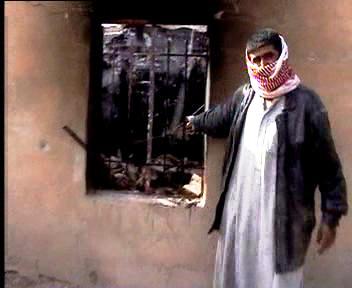 We
continued moving ahead, passing the first houses of the village, which were burnt. Then we stopped in front
of a mosque. I got out and started filming. From inside there were many holes from BKC
machine guns in the walls of the mosque and some clear damage to the structure. I heard someone say, “Do not
film [my face].” As I left the mosque I found four young people; they seemed exhausted, pale and angry, as
though they had been sleeping outside. I found out later that they were guarding their village from looters.
One of them was very angry. He was shouting, “Now you come after three days, bringing help: to whom shall we
give it? No one is in the village. All left or died.”
We
continued moving ahead, passing the first houses of the village, which were burnt. Then we stopped in front
of a mosque. I got out and started filming. From inside there were many holes from BKC
machine guns in the walls of the mosque and some clear damage to the structure. I heard someone say, “Do not
film [my face].” As I left the mosque I found four young people; they seemed exhausted, pale and angry, as
though they had been sleeping outside. I found out later that they were guarding their village from looters.
One of them was very angry. He was shouting, “Now you come after three days, bringing help: to whom shall we
give it? No one is in the village. All left or died.”
I asked to talk to him privately; we went to one
corner of the mosque and I said, “This tape that I will film will go to Al-Jazeera; what you say and what I
film will be shown to millions. Millions will hear you if you talk.” The man silently looked at me and then
said “Swear with almighty Allah that this tape is for Al-Jazeera.” I did. “Actually I depended on a friend
who knows Al-Jazeera reporters in Baghdad,” the man asking his friend to give him his hat so as to use as a
mask when we started the interview. I thought that he might be a militant and that he would kill me as I
belonged myself to Al-Jazeera, but signs of sadness and tiredness were clear on his face; he could not be
like that if he was a militant.
The man left me and joined the group of Red Crescent
members and Baghdad TV journalists who were talking, while I decided to start filming. I went to the first
house where I was attacked by a dog that refused to let me pass. I got in to the house, nonetheless; it was
burnt from inside and the roof had fallen in. It seemed that someone had used explosives to destroy the
house. Furniture was mixed with the wreckage of the roof. I saw a baby bed — I filmed it — then went out, to
see the four men waiting for me. It seemed they had accepted that I was serious about filming their disaster.
I made an interview with the tall man; he covered his face except his eyes, and stood before the burnt house
and car.
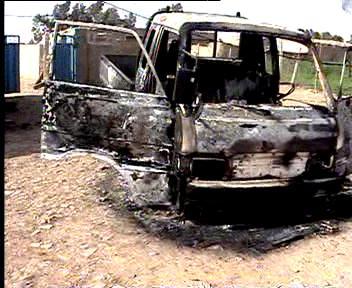 He
said, “Around 50 Chevrolet of the commandos of the police attacked our village; they were wearing black, they
killed 8 people and kidnapped 22. We may find their bodies somewhere.” The man said that the militants came
from different areas, confirming that they were Mahdi Army and Badr Brigades. The four men told me that they
would show me more of the burnt houses so I accompanied them. The Baghdad TV cameramen bothered me a lot; he
was standing close, filming me from behind. I did not want to be shown on TV, especially while I was carrying
my camera and filming. Everyone is a target, but those shown on TV are even more so.
He
said, “Around 50 Chevrolet of the commandos of the police attacked our village; they were wearing black, they
killed 8 people and kidnapped 22. We may find their bodies somewhere.” The man said that the militants came
from different areas, confirming that they were Mahdi Army and Badr Brigades. The four men told me that they
would show me more of the burnt houses so I accompanied them. The Baghdad TV cameramen bothered me a lot; he
was standing close, filming me from behind. I did not want to be shown on TV, especially while I was carrying
my camera and filming. Everyone is a target, but those shown on TV are even more so.
I asked the men to go deeper in the village. The
cameraman was afraid and returned to our ambulances. I was afraid also. The scene was horrible. The village
was deserted, and destroyed. All the houses were burnt — both clay and concrete houses were burnt. Black soot
was everywhere, over windows and doors. Cars were burnt; trucks were burnt. Animal carcasses were everywhere.
The people who had come killed everything alive. They raided the villages many times, so they might raid it
while we were there. I was suspicious of the people of Al-Mahaad village.
The tall man told me that after the raid the families
of the village settled in an area near the village. From there they saw people from the Shia areas come to
loot their village; he said: “We had to go back and kick them out.” I understood later that the militants
were near the village, waiting for the village people to return to kill them. But the village people called
on friends from other Sunni villages to come and help them. They came and a bloody battle ensued, leaving
four police cars burnt.
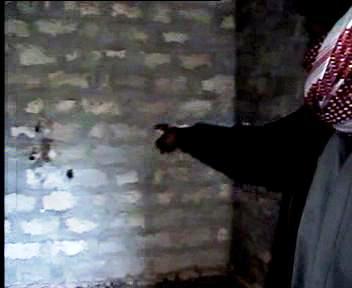 I
went on a high place and took a wide shot of the houses. The village was divided into groupings, each
containing four or five houses close to each other, each group 100 metres from the others. The men showed me
the marks of BKC bullets and Kalashnikovs. It seemed that the attackers shot on the
houses before entering them.
I
went on a high place and took a wide shot of the houses. The village was divided into groupings, each
containing four or five houses close to each other, each group 100 metres from the others. The men showed me
the marks of BKC bullets and Kalashnikovs. It seemed that the attackers shot on the
houses before entering them.
We went to one house were an entire family was
executed. I filmed it from inside (the footage was shown on Al-Jazeera later). At that moment the Americans
came. They passed near the house. I concealed myself, changed the tape in the camera, waited for the
Americans to leave, and started filming once more.
The men took me then to a house where one of them
said that a 10 year old, who had run from the attackers, had concealed himself in a room near the house. The
man pointed to the room and said, “Let me show you what they did.”
He entered the room before me — I was filming — and
said, “Come, come.” He showed me a spot of blood on the ground of the room and said that here the attackers
had executed the child. The man was very nervous. One other man said, “See the blood on the wall; there were
a four or five holes and blood spots on the wall.” It seems the child had been forced against the wall and
shot in the head. The holes were at a height 125-130 centimetres, the height of the child. We saw more bullet
holes from BKC machine guns.
The men said they found the child’s body in nearby
grasses. “We buried him half an hour before you came.” The men also buried the bodies of eight others,
including a woman, old men and children from the village.
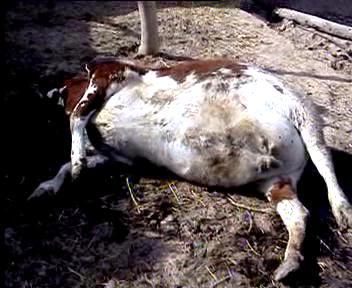 Then
we went running very fast towards another house and another executed person; the imam of the village mosque,
Sheikh Abu-Ayse. The men showed me the place were the militants told Abu-Ayse to
kneel, shooting him with a BKC machine gun and a Kalashnikov. They showed me a large bloodstain on the ground
and bullet holes from the gunfire. They said that they had killed him in front of his family.
Then
we went running very fast towards another house and another executed person; the imam of the village mosque,
Sheikh Abu-Ayse. The men showed me the place were the militants told Abu-Ayse to
kneel, shooting him with a BKC machine gun and a Kalashnikov. They showed me a large bloodstain on the ground
and bullet holes from the gunfire. They said that they had killed him in front of his family.
I forgot to ask them what happened to them, the man
saying, ‘Jafaari wants to kick Sunnis out of Baghdad; it’s a war against Sunnis. Why does he send the Wolf
Brigade, the Scorpion Brigade, the Lion Brigade, the Falcon Brigade and Mahdi Army wearing black, killing us?
They talk about terrorism, but what is this?” The man threw the cases of bullets he had been holding on a car
in anger, and then showed me his cow’s carcass. The attackers had shot the cow with a BKC machine gun. There
was a gaping hole in its neck. The other man said, “Here, they are our police, killing our animals with BKCs;
but this is not terrorism. They give them BKCs to kill our animals too … ”
Around this time the people at the ambulances started
calling me on a loud speaker. It was late and we ran fast towards the cars. I got in the ambulance, they got
in a truck and left. I went to Al-Jazeera, gave them the tapes. They showed part of the tapes, but none of
the interviews.
Appeal For Help - Sectarian Cleansing and
Coercive Displacement
Voice of Freedom for Human Rights
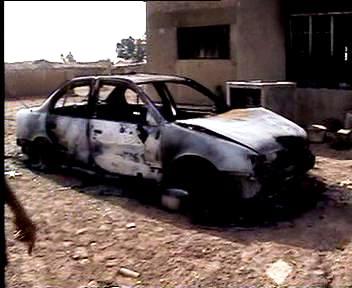 Undeclared
sectarian war and bloodshed are still underway in Iraq, regardless of non-stop calls to put an end to them,
which are warning against being dragged into civil war, which will definitely end up with casualties from all
parties involved.
Undeclared
sectarian war and bloodshed are still underway in Iraq, regardless of non-stop calls to put an end to them,
which are warning against being dragged into civil war, which will definitely end up with casualties from all
parties involved.
Below are the details of this ongoing war:
On March 2, 2006, an envoy of the Voice of Freedom for Human Rights and the Red Crescent
visited Al-Fursan Village, located near An-Nahrawan in Madaen. It comprises of 60 brick and mud houses,
inhabited by more than 60 Sunni families. The village is surrounded by a number of predominantly Shiite
villages, decorated with black and red flags.
on February 27, 2006, Al-Fursan village was attacked by hordes of men in black, who were
driving cars of the ministry of interior and state-backed militias. A large number of the villagers fled
their homes. Eight people, including the Imam of the village mosque, whose name is Abu Aisha, and a ten
year-old boy called Adnan Midab, were executed. Please find the attached photograph of the room in which
Adnan was hiding and was later killed. A number of dead animals (sheep, cows and dogs) were also shot at by
the attackers.
The village mosque was sabotaged and burned down like almost all the houses in the
village. When the relief workers and VOF envoy were in the village, four men, who were hiding outside the
village came back stealthily to recount the details of the attack. They stated that the perpetrators used
machinegun, Kalashnikov, explosives and fuel to carry out the attacks. Given the fact that the villagers
thought that it was the security forces, they did not take any precautionary measures to protect themselves.
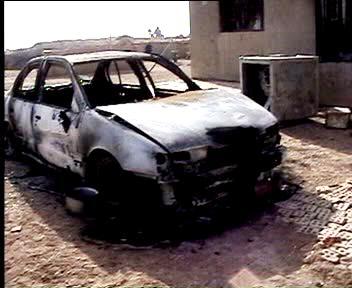 The
aforementioned men, who were hiding outside the village showed us where the dead bodies of men, women and a
child were buried.
The
aforementioned men, who were hiding outside the village showed us where the dead bodies of men, women and a
child were buried.
We saw the room, where ten-year old Adnan Midab was shot dead. We also saw the burned down
cars of the villagers.
Young men stated that they have been repeatedly harassed in order to force them into
leaving their village. After this attack, all the remaining families left to other places in Dyala and
Baghdad.
We have taken photographs of a large number of places in the village. There is a number
of isolated predominantly Sunni villages (Al-Batta, Al-Mujamma', etc, whose people were harassed by men of
the ministry of interior and militias, backed by foreigners. The latter villages are attacked on a regular
basis, but it was impossible for our staff to get into them, due to security restrictions.
The above is but the tip of the iceberg. These practices are organized and carried out on
a regular basis within towns, rural villages and suburbs. Civilians are asking for international forces to
protect them.
It is worth noting that the authorities are turning a blind eye on the perpetrators and
terrorists who have been carrying out these attacks. Failure to protect the civilians will only make things
worse.
Initial Statistics
The coercive displacement practiced by the ministry of interior, the state-backed militias
and foreigners against the people of Nahrawan is on the increase. The number of the Sunni families who have
fled their homes is as follows:
Al-Jboor Village, 50 families
Jabir Hummadi Village, 60 families
Shakha Village No. 5, 12 families
Shakha Village No. 7, 30 families
Al-Khalisa Village, 50 families
Al-Fursan Village, 60 families
Jasim Ibrahim Al-Battawi Village, 33 families
Bani Zed Village, 100 families
Al-Mujamma' Village, 100 families
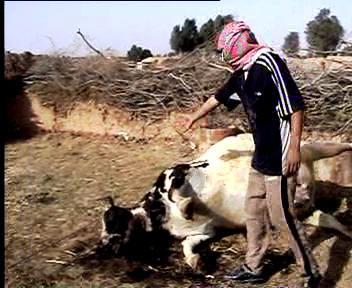
The
tragedy is mounting.
People are deprived of basic needs.
The aid workers are helpless.
The UN and
humanitarian NGOs must act and do the following:
a) - Send a Fact Finding Committee of the UN, the Arab League or International
Organizations.
b) - Send Peacemaking forces to protect the civilians and put an end to genocides,
sectarian cleansing and coercive displacement.
c) - Control the east borders of Iraq to stop the acts of terrorism perpetrated by
foreigners, who have been pouring to Iraq through the Iranian borders and raid and search the villages
harbouring them.
d) - Launch a relief program by neutral trusted parties.
Additional comment from Dirk Adriaensens:
The UN Assistance Mission
for Iraq (UNAMI), Human Rights Report, 1 January– 28 February 2006, states:
“Serious
allegations have been received by UNAMI Human Rights Office regarding the actions of some segments of the
security forces, in particular the police and special forces, and their apparent collusion with militias in
carrying out human rights violations. Allegations that "death squads" operate in the country grew stronger
following the discovery by the Multi-National Forces in Iraq (MNF-I) and the Iraqi Security Forces of a
suspicious group, acting within the structures of the Ministry of Interior. This re-affirms the urgent need
for the Government to assert control over the security forces and all armed groups. Throughout the reporting
period, insurgent activities, including terrorist acts, intensified after 22 February and continue to affect
the civilian population.”
Should the
devastating role of the US in this sectarian violence not be thoroughly questioned? The MNF-I and Iraqi
forces "discovered" the existence of at least one possible death squad within the Ministry of
Interior, the UNAMI report states.
But if you
look at the plans the US themselves have drawn for Iraq, why should they "uncover" something they have
created themselves?
According
to an article recently published in New York Times Magazine, in September 2004 Counsellor to the US
Ambassador for Iraqi Security Forces James Steele was assigned to work with a new elite Iraqi
counter-insurgency unit known as the Special Police Commandos, formed under the operational control of Iraq’s
Interior Ministry (‘The Way of the Commandos’, Peter Maass,
http://psychoanalystsopposewar.org/resources_files/TheWay_of_the_Commandos.html).
From 1984 to
1986 then Col. Steele had led the US Military Advisory Group in El Salvador, where he was responsible for
developing special operating forces at brigade level during the height of the conflict. These forces,
composed of the most brutal soldiers available, replicated the kind of small-unit operations with which
Steele was familiar from his service in Vietnam. Rather than focusing on seizing terrain, their role was to
attack ‘insurgent’ leadership, their supporters, sources of supply and base camps. In the case of the 4th
Brigade, such tactics ensured that a 20-man force was able to account for 60% of the total casualties
inflicted by the unit (Manwaring, El Salvador at War, 1988, p 306-8).
http://globalresearch.ca/articles/FUL506A.html.
Isn't it
time that the politicians in Washington stop their hypocritical double talk and answer to the question what
exactly James Steele and other US military personnel have done to incite a civil war in Iraq?
“part of a secret $3
billion in new funds—tucked away in the $87 billion Iraq appropriation that Congress approved in early
November—will go toward the creation of a paramilitary unit manned by militiamen associated with former Iraqi
exile groups. Experts say it could lead to a wave of extrajudicial killings, not only of armed rebels but of
nationalists, other opponents of the U.S. occupation and thousands of civilian Baathists—up to 120,000 of the
estimated 2.5 million former Baath Party members in Iraq. (…) The hidden $3 billion will fund covert
(“black”) operations disguised as an Air Force classified program. According to John Pike, an expert on
classified military budgets at
www.globalsecurity.org, the cash, spread over three years, is likely being funneled directly to the CIA,
boosting that agency’s estimated $4 billion a year budget by fully 25 percent. Operations in Iraq will get
the bulk of it, with some money going to Afghanistan. The number of CIA officers in Iraq, now 275, will
increase significantly, supplemented by large numbers of the U.S. military’s elite counterinsurgency forces.”
http://www.prospect.org/print/V15/1/dreyfuss-r.html. 01 January 2004.
What we witness now is the
result of that US policy of creating, training and funding militia’s and death squads. Why doesn’t the UNAMI
report tell us the truth in their report? Why don’t they do their job properly? And why does the mainstream
press keeps on repeating His Master’s Voice, when they know that the Bush Administration is solely
responsible for the atrocious state the Iraqis find themselves in.
Schools
in Iraq
Isam Rasheed Abdul-Rahman (24 March
2006)
Today we write about schools in Iraq, and how
occupation affects them.
I tried to get close to teachers, to find out
how they work now, and what kind of problems they face in schools at present.
The first teacher I spoke to was Mohammed Akram,
36 years old, who works in Al-Karama primary school.
“I’ve been teaching for eight years,” he
said, “and I regret to say the schools in Iraq have deteriorated. The situation inside the schools became very
bad, due to bribery, and there is not enough control from the Iraqi government on schools. Some students don’t
respect teachers inside the classroom. It was better before the war because had power to control students.”
“Some teachers are sectarian and treat students
badly according to name (some names, like Omar, are used mainly by Sunnis, while others, like Abdul Hussain,
are mainly use by Shias).
We have low education levels and the educational
materials are not enough; the Ministry of Education didn’t print enough books for students.”
Are the schools being rebuilt by the occupation?
Not rebuilt. They repaired some schools, only by
painting the walls and changing some desks, etc.
Do you let your children go to school?
Yes, but I take them myself and my wife collects
them; we are afraid of car bombs, roadside bombs, or our children being kidnapped.
Recently, US troops stopped one of the school
buses for girls in Mosul, north of Baghdad 400 kilometres. They forced the girls to take off their veils and
the US troops did body searches. It is not allow in Islamic society for men to search women’s bodies.
Can the Iraqi government fix these problems?
No, they can’t, because they don’t have enough
power to ban US troops from entering schools.
Are there some schools that are doing well while
others are not?
No. All of them suffer because of the
occupation.
Is there difference between Sunni and Shia and
Kurdish schools?
Yes. I think the schools in Kurdistan are better
than Baghdad schools, and also the teachers there — in Kurdistan — take high salaries than teachers in Baghdad
and south Iraq.
As to Sunni and Shia, they go to the same
schools and so have the same conditions.
My second interview was with Majeed Ma’ad, 34
years old, a teacher in Salah Al-Deen secondary school in Sha’ab area, east Baghdad.
“Before I was in a school near by the main
checkpoint in east Baghdad,” he said, “and we blocked all the windows with sandbags to protect the students
from bullets because there were resistance operations against US troops there.”
“I think,” Majeed continued, “if this situation
continues other two years all the schools will stop working because the situation became impossible. Most
teachers take bribes, which means the students don’t respect them. We ask the Iraqi government to find way to
stop that. We can’t force the students to respect us.”
Do you let your children go to school?
I’m not married yet, but I think this is one of
biggest problem for Iraqi families, to send their sons to schools with this situation in Iraq. But what can
they do? There is no way to teach children outside schools.
When will schools be properly functional?
I think after the end of occupation.
There were 7500 schools in Iraq before
the war and now
this number became less than 7300 because
occupation forces bombarded many schools during the war, and during the Fallujah offensive. They occupied
others, especially the schools in the west of Baghdad. They made these schools a military camp, and in
Fallujah the children learn under tents now.
Are there some schools that are doing well and
some that are not?
I don’t think so because we all live in Iraq
under occupation.
Is there difference between Sunni and Shia and
Kurdish schools?
No, because all Iraqi students, Sunni, Shia and
Christians,
go to the same schools. Only in Kurdistan are
there Kurdish only schools because there are no Arab families living there, but still there is no difference
between all.
My third interview was with Mr Mohammed, 35
years old, guard in Al-Sifina primary school, northeast Baghdad. “We have very bad condition in Iraq,” he
said, “and these conditions are also inside our schools. Today we received a written threat. They wrote,
‘close the school or we will killed the director and all of the guards.’ We don’t know what can we do.
I told all of my neighbours and we made
security plan to protect the school.”
Did you call the police?
No, because we don’t trust them and I don’t
think they will protect us.
Have you heard of many incidents in schools?
Yes, many.
In Al-Numan primary school one guard was
killed on the 6th of this month.
The director and other one guard were killed in
Cairo school, east Baghdad.
The director in one of Sha’ab district’s schools
was killed last week too. And in another secondary school for girls they killed the director and kidnapped two
girls. All these crimes are committed by secret armed men, and occurred in the last 20 days.
Who is committing these crimes?
US troops used this plan in Vietnam during their
occupation — the so-called Phoenix Operation. They use it the same strategy now in Iraq. They just want to
make mess in Iraq.
Do you let your children go to school?
No, of course not, because there is no security
at all.
How were the schools before the war?
For sure it was much better than now. There was
good security, good education, no bombing on schools, no military troops entering schools.
My last interview was with Eman Hamad, 40 years
old, a housewife, who I met near one school when she was collecting her son.
Can you tell me about how the situation in
schools adds hardship to your life?
Oh, what can I say? This question needs a long
time answer, to tell you how we mothers suffer from this situation, and how it affects schools in Iraq.
Every day I leave my work in my house in
morning to bring my son to the school and I do the same when I bring him back.
We are afraid our sons will be kidnapped,
which is why we come to guide our sons home, and we also we afraid of car bombs, roadside bomb and occupation
forces, because sometimes they open fire without reason, just to scare people.
When will schools be properly functional again?
When the occupation ends. And also when we have
a national government representative of all Iraqis.
Are there some schools that are doing well and
some that are not?
Yes, because some schools have good teachers and
have computers and new buildings with laboratories; with all of that help these schools are doing well, unlike
others.
What are your hopes for Iraqi schools in future?
I hope Iraqi schools will be safe like any other
schools in the world.
Uniformed Death Squads:
Terrorizing Iraq into Disintegration
Sabah Ali
- 10 May 2006
Two long queues
of empty coffins are waiting at the hospital gate. Men and women, weary faces under the blazing sun, looking
for a father, a son, a husband, a brother, a cousin…etc who disappeared days ago. The families are (hoping)
that they would find their loved ones today. They heard that police patrols, specialized in looking for dead
bodies in Baghdad streets every morning, have collected 93 bodies from different garbage and sewage places.
The hospital
cold storage can not keep more than few tens (in the past they had no more than 10), but they added new ones.
Still they can not cover. They keep the bodies for few days, or they do not keep them at all, it all depends
on the number. They take pictures of the unidentified bodies, give them numbers, try to find whatever
distinguishable mark before burying them, so that they have answers for the families who are waiting in the
sun.
Some of the
bodies are tortured and deformed beyond recognition, no eye(s), skin peeled or burnt…some do not have IDs,
some with slaughtered necks, some shot in the head from a close distance, but all with hands and eyes tied,
most of them young.
Now
and then, women's shrieks and police and ambulances sirens cover the people's shouts. Many hours later, the
coffins slowly move away, filled with bodies empty, to come the next day looking for the loved ones.
According to
many sources, at least 1500 Iraqis are killed monthly in the last 4 months. Many of the kidnapped or the
arrested never return or found. A shop keeper in Baghdad asked to be executed in his shop when some masked
(police) men wanted to arrest him. He refused to go with them, to be exposed to the brutal torture and
insisted on being killed on the spot. The policemen did not say no. They shot him dead and left calmly.
Thousands of Iraqis (One hundred thousands, according to a most recent report) are now displaced, fleeing
neighborhoods where they are a minority, a very dangerous step towards dividing Iraq into different sectarian
and ethnic regions.
The Prime
Minister, Nouri Al-Maliky, admitted in a press conference May 9, 2006, that the death squads are part of the
Iraqi police forces, but he said that they were working on their own, and that they used the police uniform,
cars, and weapons in committing their crimes. He promised to "clean" the interior ministry of them!! But in
his first day in office, Maliky invited the sectarian parties' militias to join the security forces!!
The Minister of
Interior, Bayan Jabr Soulagh, on his part, admitted that a major general in the Iraqi police is responsible
for the death and kidnapping squad Many high police and army officers were said to be arrested few days
earlier. Al-Maliky and Soulagh (both from the Shiite Coalition) confessions came two days before the new
government to be announced. Soulagh and the Shiite collation in the Parliament struggle to keep the job of the
minister of interior in the hand of the Coalition in the new long delayed government, despite the fact that
all the other members of the Parliament are against him, on the background of the death squads.
It is widely
understood that these confessions were no more than a political maneuver to keep the post and that the major
general mentioned above (if he exists at all) is no more than a scapegoat, a way of clearing the interior
ministry and its sectarian troops from the death squads crimes since Al-Jafari took office early 2005.
It
is argued that Soulagh did allow the sectarian militias in the police to use their authorities and commit all
their collective arrests, killings and torture. Otherwise who sent the big and heavily armed police patrols
during the night curfew!! Who opens the jails doors to receive the hundreds of detainees, and torture them
before they were slaughtered, strangled, shot…and thrown on the garbage or the sewage!! How is it possible
that these big convoys of armed men move freely during the curfew without being noticed by the police and the
American troops!! Why is it that Soulagh was justifying and defending the police when he was confronted by
their crimes in the past!!
The American
troops are also committing now on the spot executions of men in front of their families. In Samarra and Ramadi
at least three cases were documented of the American soldiers killing members of families in front of
civilians. Last year, according to an eye-witness, the American troops slaughtered by bayonets two men and
shot the third in his mouth in a village north of Baghdad.
It is not a new
phenomenon in Iraq in the last 3 years. Earlier in 2003 and 2004, some bodies were found slaughtered or shot
in different parts of Iraq, especially in the west and the north. The victims were known for being
collaborators or informers, or even translators to the American troops. Some bodies of men who were arrested
by the American troops were also found near hospitals or in deserted places. But they were relatively few
registered incidents, in both cases. Many Iraqis who were arrested by the American troops disappeared,
especially those who were injured.
Through 2005,
during Al-Jafari government, the phenomenon became much bigger, when hundreds of Sunnies' bodies , those who
were arrested by the new Iraqi police or army days earlier, were found , brutally tortured or burnt, holes
drilled in their bodies, nails, teeth and eyes pulled out, bones broken…etc. Many prisoners who were later
released talked about the same kinds of torture in the Ministry of Interior prisons in different parts of
Baghdad and other governorates.
The
situation developed into collective random arrests in Sunnie and mixed areas in Baghdad. In Al-Madain, Al-Sho'la,
and Al-Hurria, among other places, men were arrested according to their family names. Tens of men at a time
were arrested by uniformed, armed and masked men saying that they are from the Iraqi security forces, driving
sign-less pick ups and big new cars. When the families ask in the interior ministry, the officials deny
sending any patrols.
Among the famous
stories of this kind was in Al-Sho'la last summer, when 35 men from one street were arrested one night in the
same way, and their bodies were found on the Iranian borders few weeks later. Another story was of 11 young
workers who were driving home on July10, 2005, were arrested by the police, and locked in a closed container
to suffocate to death. On February 23, 2006, the young well known Iraqi Journalist Atwar Bahjat was kidnapped
by masked men, tortured by electric drill; tens of holes were found on her body, slaughtered and bled to
death. The crime was video filmed.
Thousands of
horrible stories and pictures were published in many Iraqi newspapers and shown in press conferences organized
by Human Rights organizations in the last 2 years. The American authorities pretend that they do not know
about these atrocities. (The Iraqi biggest prisons are controlled by the Americans). In March 24, 2006, New
York Times published a front page saying that the American officers are training the Iraqi police on human
rights (!)after they trained them on fighting the insurgency, implying that the situation in the Iraqi prisons
has become intolerable!!!
After
the attack on the Al-Askari and Al-Mahdi shrines in Samarra in February 22, 2006, the situation changed
dramatically. (Interestingly enough, many American mainstream publications said then that this is a breaking
point for Iraq). It was. From that date on, thousands of Iraqis were killed, kidnapped or disappeared.
The Non Violent Iraq Net,
a net of 125 Iraqi organizations, published statistics about the last 4 months saying that there were 5743
military operations happened in Iraq since the beginning of this year. Baghdad, Baquba and Anbar had the
biggest part of them. The operations included destroying mosques, family displacement, kidnapping, threatening
people and shooting at civilians. 95% of these operations were registered against unknown!! According to
Al-Mashriq Daily, the director of Baghdad morgue told Reuters that
4442
bodies were brought to the morgue in the first 4 months of 2006 in Baghdad alone, and if the governorates
(regions) are counted, the number is well beyond 1500 a month.
To Be Continued
The "Deal Government" Fiasco and Iraq's Future
Sabah Ali
(21/05/2006)
To any political observer, watching the Iraqi government
formation the last five month was fun, a dark or absurd comedy. Since Nouri Al-Maliky, the Iraqi new prime
minister, optimistically announced that he is going to form a government in 24 hours a month ago, he was
drowned in so many pressures and problems between the political parties and the parliamentary groups who wan
the elections in December15, 2005 that a month later there was no white smoke coming out of the Parliament's
chimney!! Maliky had to swallow his hasty tongue and work for 16 hours a day, negotiating the political
(aspirations) of the different groups. Finally, the political process elephant gave birth to a crippled rat,
by a cesarean operation.
Maliky had to present a government minus Interior and Defense
ministers and the National Security Council- the main problem that delayed the government formation- and
without a political program, which he promised to present in a month. This tactic of jumping forward,
postponing the biggest problem to some point in the future, has become a routine procedure by the Iraqi
authorities since 2003, to bypass the real problems facing the political process, as if it is an end in
itself...
It would be fair, however, to say that it was not all Maliky'
fault. He had to satisfy everybody's multi level special aspirations. Above all, there are the Americans, the
Shiite Coalition to which he belongs, the parliamentary groups, the political parties within these groups, and
individuals inside the parties. Each of them has his agenda and wants a ministry or a high post. As the
ministries are limited in number, he had to create new ministries, or sub-ministries; a council, a board, a
body, or a state portfolio here and there. We have 37 ministries so far, a part from the councils and
boards…etc. The cake can not fill all the open mouths. He ended up with a government accused of being heavily
sectarian, instead of the national unity government he promised.
Maliky did thank –in his inauguration speech- the (Shiite)
religious great references, as he called them, especially Sistani. He promised to defeat terrorism and
violence (as we defeated the tyranny, he said) He did not mention any thing about the hundreds of thousands of
the occupation troops, the armed militias, the resistance, or the 14 American permanent military bases in
Iraq. Actually, he promised to work in cooperation with the "coalition" troops until it is realistically
convenient for them to "go back to their countries"(He did not say to leave Iraq)
It is important to remember, at this point, that the UN
Security Council "mandate" for the occupation troops in Iraq ended by the end of 2005. Apart from ex-prime
minister Jafari's "invitation", they do not have any "legal" cover to stay. This fiasco is very useful for
them to say that they are staying as far as the Iraqis are not ready yet to run the country, which is well on
the threshold of civil war. The Iraqi first government relishes full American guardianship.
The
question remains how such a government, with its member's mutual suspicions, hidden agendas, and sectarian
and ethnic entrenchments, is going to tackle the huge complications of the Iraqi situation, ? None of them
trusts the others to allow them to control the security forces. The Shiite United Coalition accused the
others of stealing their electoral entitlements, and trying to (shift chairs). Some Sunnis accused the Shiites
of working on their agenda of dividing Iraq by controlling the (sovereignty) chairs, and left the session
angrily. The Fadhila party (member of the Shiite Coalition) which wanted the Oil Ministry left the
government negotiations because the job was given to the Iraqi nuclear "scientist" Shahristani, accused the
whole process of being wrong and selfish, and joined the "opposition" inside the parliament.
The National
Dialogue Front said that they were double crossed. They objected that the Foreign Minister should be an Arab,
so an office was created for Iraqi-Arab relations inside the Foreign Ministry to satisfy this need, and a
ministry of national dialogue was also created, but they left the government all the same. The Iraqiya Front
of ex-prime minister Allawi was watching silently, unhappy that they were not given five ministries…
Ironically
enough, all of these vehement defenders of the chairs, talked in a double discourse: on one hand they talked
about abandoning and renouncing sectarian and ethnic approach in distributing the chairs, and about choosing
ministers according to their "technical and political efficiency", not their religious, ethnic, or personal
affiliations. But NONE of them, on the other hand, rejected or accepted their or the others shares on bases
of differences in a political attitude, an ideological point of view or on electoral agendas or programs, all
their objections were based on how much they or the others get.
Much more
interesting, and telling, however, is the fact that all these "patriots" were quarreling on three main
ministries: Oil, Defense, and (especially) Interior. No one fought for the ministry of health, education,
transportation, or electricity….etc, those ministries which are in shambles and which are badly needed by the
Iraqis, but not seen as important enough for the contesters. This does not mean that the three most wanted
ministries above are in a better condition, on the contrary, they are eaten up by corruption and mismanagement
according to high officials in the government them selves*, but these are the "sovereignty" posts. It is
widely understood by the Iraqi politicians now, that those who "own" the interior ministry, for example, own
Iraq and its future.
The Shiite
United Coalition leader, Al- Hakeem, built his center-south federal region project on a fallacy that the
(Shiite Iraq) extends from Samarra (north center) to Faw port on the Gulf. Large parts of Baghdad, Anbar, and
Diyala are supposed to be parts of the "Shiite Iraq". This "theory" explains the brutal sectarian
cleansing in the Baghdad suburbs in all geographical directions. It also sheds good light on the Samarra
explosions enigma which ignited the sectarian riot. It is very important for the Shiite to keep the Interior
Ministry now to "finish" the job of liberating the Shiite areas from the Sunni occupation with the help of the
Americans.
All other
political parties were against the United Coalition keeping the Interior Ministry, on the background of
thousands of killings, arrests and torture connected to it. Significantly enough, Zarqawi announced for the
first time that he is going to defend the Sunnis (who gave him this authority?!!) and that he is going to
create his Islamic state within three months!! Of course, Kurdistan is already separated from the rest of
Iraq, practically speaking. The south is controlled by the Shiite seven major parties, which have many
disputes and feuds among them. The question is how the new government looks at the disintegration danger, an
issue Maliky did not mention in his political program.
What makes
all this fiasco looks even worse, whether Maliky succeeded in making this deal government work or not, is that
the Iraqi government, whatever it is, actually has no authority at all, less of control on any thing:
security, resources, corruption, armed militias, death squads, the occupation atrocities, the Turkish and
Iranian military threats, and the promised constitution revision, not to mention any thing about the country
that collapsed, in all the senses of the word. The failure the new prime minister has shown so far, the huge
problems of just putting a government together, and the conflicts of interests and loyalties, do not light up
any corner in the dark tunnel this nation is going through, as far as the occupation is there.
------------------------------------------------
* The ex-minister
of oil, Ibrahim Bahrl Olom, said that millions of barrels of Iraqi oil, worth billions of dollars, are
smuggled by mafias in Baghdad and the south, to the knowledge and help of the high Iraqi officials. The Iraqi
General Inspector office published the annual report lately saying the same. It is widely understood that the
Ministry of Oil fire in the files departments two weeks ago was done to conceal the evidences. In his first
press conference, the new Oil Minister, Shahristani, promised to deal with corruption as his priority.
 Iraqi
Doctors Beaten and Arrested in Haditha Hospital (30 Oct.2005) |
Al qaim October Massacre: Indiscriminate Killing Zone (04
Nov.2005) | Haditha: River
Gate… to Hell (06 Nov. 2005) |
Yosfiya:
The 21st Century Nazis Are Here (20 Nov.2005)
| ‘Even
during operations, doctors were shot at by US soldiers’ (07 Dec 2005) |
Al Qaim revisited -
Behind the Steel Curtain: The Real Face of the Occupation
(18 Dec 2005) |
Foto album of the devastated city of Al Qaim
(18 Dec 2005) |
Inside Iraq's secret prisons: an Iraqi
testimony (19 Dec 2005) |
Attending a Human Rights Meeting, or: one morning in
Baghdad... (07 Jan 2006) |
Broken Promises
(01 Feb 2006) |
Death Squads and Iraqi
police: two sides of the same coin
(03 March 2006) |
Children of Abraham: Death in the
Desert (Isahaqi - 15 March 2006) |
Militants of
Jafaari commit massacre in Al-Fursan village. US sponsored death squads in action (23 March 2006) |
Schools in
Iraq (24 March 2006) |
Uniformed Death Squads: Terrorizing Iraq into Disintegration
(10 May 2006)
| The "Deal Government" Fiasco
and Iraq's Future (21/05/2006)
Iraqi
Doctors Beaten and Arrested in Haditha Hospital (30 Oct.2005) |
Al qaim October Massacre: Indiscriminate Killing Zone (04
Nov.2005) | Haditha: River
Gate… to Hell (06 Nov. 2005) |
Yosfiya:
The 21st Century Nazis Are Here (20 Nov.2005)
| ‘Even
during operations, doctors were shot at by US soldiers’ (07 Dec 2005) |
Al Qaim revisited -
Behind the Steel Curtain: The Real Face of the Occupation
(18 Dec 2005) |
Foto album of the devastated city of Al Qaim
(18 Dec 2005) |
Inside Iraq's secret prisons: an Iraqi
testimony (19 Dec 2005) |
Attending a Human Rights Meeting, or: one morning in
Baghdad... (07 Jan 2006) |
Broken Promises
(01 Feb 2006) |
Death Squads and Iraqi
police: two sides of the same coin
(03 March 2006) |
Children of Abraham: Death in the
Desert (Isahaqi - 15 March 2006) |
Militants of
Jafaari commit massacre in Al-Fursan village. US sponsored death squads in action (23 March 2006) |
Schools in
Iraq (24 March 2006) |
Uniformed Death Squads: Terrorizing Iraq into Disintegration
(10 May 2006)
| The "Deal Government" Fiasco
and Iraq's Future (21/05/2006)  We had to postpone our trip to Al-Qaim and Haditha several times for 2
weeks. Many times the road was closed because of some military operations. We decided to go to the refugee
camps first, be ready to move from there as soon as the road is clear. There were 8100 refugee families now
(last time, before Oct 1, they were 7450) distributed on the nearest towns, villages and in the desert. Some
of the camps were cut from any kind of relief, especially those which were across the Euphrates, because the
American troops bombed all the bridges in Alqaim (3) and Haditha (2). The need now is for thick
clothes, especially for children, blankets, and medicines for daily use, apart from food. The new families
were those who escaped the latest attack on Alqaim (Oct1) and Haditha (Oct 5) The River’s
Gate, as it was called. One of the biggest emergency relief organizations in Iraq now admitted that they
can not reach the behind-the-river villages.
We had to postpone our trip to Al-Qaim and Haditha several times for 2
weeks. Many times the road was closed because of some military operations. We decided to go to the refugee
camps first, be ready to move from there as soon as the road is clear. There were 8100 refugee families now
(last time, before Oct 1, they were 7450) distributed on the nearest towns, villages and in the desert. Some
of the camps were cut from any kind of relief, especially those which were across the Euphrates, because the
American troops bombed all the bridges in Alqaim (3) and Haditha (2). The need now is for thick
clothes, especially for children, blankets, and medicines for daily use, apart from food. The new families
were those who escaped the latest attack on Alqaim (Oct1) and Haditha (Oct 5) The River’s
Gate, as it was called. One of the biggest emergency relief organizations in Iraq now admitted that they
can not reach the behind-the-river villages.  A young man, H.Khalaf, was lying on a trolley, soaked in blood. He was shot
in his genitals by an American sniper while he was going home from the market just across the street. The
shot injured his right thigh, his testes, and went out through his left thigh.
A young man, H.Khalaf, was lying on a trolley, soaked in blood. He was shot
in his genitals by an American sniper while he was going home from the market just across the street. The
shot injured his right thigh, his testes, and went out through his left thigh. In the ward another young man, Salah Hamid, was shot under the belt too. He
was driving his taxi at 10 am on Monday Oct17, 2005 in the market place when he was shot by the American
snipers. Salah was so angry that he cried and used obscene words (unacceptable in those areas). His car
was completely ruined. The doctor explained that a large part of his intestine had to be cut.
In the ward another young man, Salah Hamid, was shot under the belt too. He
was driving his taxi at 10 am on Monday Oct17, 2005 in the market place when he was shot by the American
snipers. Salah was so angry that he cried and used obscene words (unacceptable in those areas). His car
was completely ruined. The doctor explained that a large part of his intestine had to be cut.


 The ambulance driver, Mahmood Chiad, 35, was going to Karabla, to help some
injured family during the attack. He was shot and killed by a bullet in the left chest. The ambulance was
then hit by a grenade which ripped it in two parts, and burnt it. It was still there, but we could not film
in the no man’s land, as they call it. Mahmood left a widow and six children; the oldest of them, Aimen
(m), is 10 years old. “The family was not given any compensation or pension” said his colleague Muneer
Said “he was very poor, living in a tin extension of a house, his family should be taken care of”.
The ambulance driver, Mahmood Chiad, 35, was going to Karabla, to help some
injured family during the attack. He was shot and killed by a bullet in the left chest. The ambulance was
then hit by a grenade which ripped it in two parts, and burnt it. It was still there, but we could not film
in the no man’s land, as they call it. Mahmood left a widow and six children; the oldest of them, Aimen
(m), is 10 years old. “The family was not given any compensation or pension” said his colleague Muneer
Said “he was very poor, living in a tin extension of a house, his family should be taken care of”.  In the emergency ward, a girl of ten was lying on one trolley, and a young woman on
another. They were still conscious. The girl, Yosr Jasim Mohammad Al-Ta’i, 10, (going to 5th
grade, as she said proudly), was injured in her feet, back, and right ear, which were covered with blood.
She did not know that she is the only survivor of a family of 8. Her father, her mother Ibtisam Thiyab
Othman, and five of her brothers and sister were buried dead under the rubbles when the American
airplanes bombed Al-Ish village at 2 am that day, Oct 26.2005.
In the emergency ward, a girl of ten was lying on one trolley, and a young woman on
another. They were still conscious. The girl, Yosr Jasim Mohammad Al-Ta’i, 10, (going to 5th
grade, as she said proudly), was injured in her feet, back, and right ear, which were covered with blood.
She did not know that she is the only survivor of a family of 8. Her father, her mother Ibtisam Thiyab
Othman, and five of her brothers and sister were buried dead under the rubbles when the American
airplanes bombed Al-Ish village at 2 am that day, Oct 26.2005. 
 The first family was of Saggar Hamdan, a Land Cruiser driver who was taking
his- and his brother in law’s- families to the Okashat refugee camp 200 kilometers away in the desert
at 4 pm on the attack first day. His father explained that” there were 19 women and children in the car when
it was shot and burnt by the American troops. Saggar , his wife Khadija, and his 6 children
(Ala’(m)10, Adil (m), Omar(m), Sheima’(f), Lamia(f)’, and a baby) and his niece were killed. No
one was allowed to approach the car until it was no more than ashes”. It was only after 5 days that a cousin,
Hashim Hamid, was allowed to get the bodies.
The first family was of Saggar Hamdan, a Land Cruiser driver who was taking
his- and his brother in law’s- families to the Okashat refugee camp 200 kilometers away in the desert
at 4 pm on the attack first day. His father explained that” there were 19 women and children in the car when
it was shot and burnt by the American troops. Saggar , his wife Khadija, and his 6 children
(Ala’(m)10, Adil (m), Omar(m), Sheima’(f), Lamia(f)’, and a baby) and his niece were killed. No
one was allowed to approach the car until it was no more than ashes”. It was only after 5 days that a cousin,
Hashim Hamid, was allowed to get the bodies. The second family was of Mohammad Jabir, a boy of nine years who was shot by
an American sniper at his house door in the “Death Street” on Thursday Oct 20, 2005.
The second family was of Mohammad Jabir, a boy of nine years who was shot by
an American sniper at his house door in the “Death Street” on Thursday Oct 20, 2005. 


 The third family was of Attiya Mikhlif. The house was no more than a heap of
rubbles. It was bombed at 6 am on August 30, 2005. There was no one of the family left to tell the story.
Neighbors were hesitant to talk. “The old man died years ago” one of the neighbors volunteered to talk at
last. “There was his old wife, Dalla Hardan 55, his three sons, Daham 35, Rashid 25, and
Salman 18, and two daughters in law: Rafaah 19 and Kholood 19. Rashid, his bride Rafaah,
Salman and his bride Kholood were all newly married”. All of them were killed that morning.
The third family was of Attiya Mikhlif. The house was no more than a heap of
rubbles. It was bombed at 6 am on August 30, 2005. There was no one of the family left to tell the story.
Neighbors were hesitant to talk. “The old man died years ago” one of the neighbors volunteered to talk at
last. “There was his old wife, Dalla Hardan 55, his three sons, Daham 35, Rashid 25, and
Salman 18, and two daughters in law: Rafaah 19 and Kholood 19. Rashid, his bride Rafaah,
Salman and his bride Kholood were all newly married”. All of them were killed that morning. 



 K
K In
In
 one of the houses in Al-Salaam district, Alwan Abdul Kareem refused
to stay with his family in the refugee camp in Anah. He found it unbearable to live as a refugee, so
he returned home alone 4 days later. The house was bombed on the same day (Oct 22), he was killed under the
heavy stairs where he was hiding, eating his sohoor (the last meal before fasting). Alwan was
58, a gardener and a school guard. We met his family in Anah refugee camp. He left a wife Shokriya,
40, and eight children.
one of the houses in Al-Salaam district, Alwan Abdul Kareem refused
to stay with his family in the refugee camp in Anah. He found it unbearable to live as a refugee, so
he returned home alone 4 days later. The house was bombed on the same day (Oct 22), he was killed under the
heavy stairs where he was hiding, eating his sohoor (the last meal before fasting). Alwan was
58, a gardener and a school guard. We met his family in Anah refugee camp. He left a wife Shokriya,
40, and eight children. 





 “Is
it not dangerous to go back home now, while the situation is still not safe?” (One of the biggest attacks
eventually began on Nov 5, 2005 named Steel Curtain, 3500 American and Iraqi troops participated in
it)
“Is
it not dangerous to go back home now, while the situation is still not safe?” (One of the biggest attacks
eventually began on Nov 5, 2005 named Steel Curtain, 3500 American and Iraqi troops participated in
it)
 Realizing
that there is no chance of opening the road that day, the drivers decided to move, and try another checkpoint. This one was open allright, but the queue was so long that you could not see its end. The search was so
minutely that it takes at least 10 minutes for one car from either side to move. Some families tried to talk to
the American soldiers to make it easier for the children and old people. He was kind and promised to help
“but I have orders” he said. Breakfast time was approaching, all the people were fasting.
Realizing
that there is no chance of opening the road that day, the drivers decided to move, and try another checkpoint. This one was open allright, but the queue was so long that you could not see its end. The search was so
minutely that it takes at least 10 minutes for one car from either side to move. Some families tried to talk to
the American soldiers to make it easier for the children and old people. He was kind and promised to help
“but I have orders” he said. Breakfast time was approaching, all the people were fasting.  Those
who follow the American occupation of Iraq news may be familiar with a term used in media almost two years
ago: The Triangle of Death, an area south of Baghdad, which constitutes of three relatively small towns;
Yosfiya, Mahmoodiya and Latifiya. Of course it has nothing to do with death; on the contrary it is
situated in one of the greenest, most beautiful and peaceful areas of Iraq, full of fruit orchards, vegetable
farms where the Tigris and the Euphrates and many smaller canals flow calmly through the rural areas
and hundreds of small villages. It also used to be one of the most important industrial areas in central
Iraq, especially textiles. But it is branded Triangle of Death by the American troops now, because they face
the largest number of attacks on the southern high way there.
Those
who follow the American occupation of Iraq news may be familiar with a term used in media almost two years
ago: The Triangle of Death, an area south of Baghdad, which constitutes of three relatively small towns;
Yosfiya, Mahmoodiya and Latifiya. Of course it has nothing to do with death; on the contrary it is
situated in one of the greenest, most beautiful and peaceful areas of Iraq, full of fruit orchards, vegetable
farms where the Tigris and the Euphrates and many smaller canals flow calmly through the rural areas
and hundreds of small villages. It also used to be one of the most important industrial areas in central
Iraq, especially textiles. But it is branded Triangle of Death by the American troops now, because they face
the largest number of attacks on the southern high way there. 


 The
Iraqi police Special Forces, Al-Hussein Brigades, came at dawn. There were around 20 pick ups full of
them. They were hit on the highway very badly from a place behind the Yosfiya Water Project, east of the
village. Tens of them were killed. Their cars were burnt. Some of them hid inside the village. The battle
went on for 3 hours. In the end some of them managed to run away. In the afternoon, the same day, more forces
returned back accompanied by the American troops and helicopters. They evacuated their dead, raided the
houses, killed and arrested the men, humiliated the families, killed the cows and chicken, destroyed the
yards, and set the village on fire.
The
Iraqi police Special Forces, Al-Hussein Brigades, came at dawn. There were around 20 pick ups full of
them. They were hit on the highway very badly from a place behind the Yosfiya Water Project, east of the
village. Tens of them were killed. Their cars were burnt. Some of them hid inside the village. The battle
went on for 3 hours. In the end some of them managed to run away. In the afternoon, the same day, more forces
returned back accompanied by the American troops and helicopters. They evacuated their dead, raided the
houses, killed and arrested the men, humiliated the families, killed the cows and chicken, destroyed the
yards, and set the village on fire.





 -“I
want the government to hear my question and answer me: why were we treated like this? The police brigades
broke even the electricity converters, we do not have power for 40 days, of course water pumps do not operate
and the plants are all dead. Our animals were killed, our women humiliated. They ask the women where did you
hide the men, they grabbed the children from their hair and throw them to the ground.
-“I
want the government to hear my question and answer me: why were we treated like this? The police brigades
broke even the electricity converters, we do not have power for 40 days, of course water pumps do not operate
and the plants are all dead. Our animals were killed, our women humiliated. They ask the women where did you
hide the men, they grabbed the children from their hair and throw them to the ground. 


 -“I
tried to save something, but I could not, they would not let me. They came in four helicopters and surrounded
the whole area. They put the gun on my head and asked where the mojahideen are. They destroyed
everything, even my medicines. They said you help the mojahideen with those medicines, and destroyed
them. Troops from the police Scorpion brigade were hit in the area the day before, and they believed that we
knew about the mojahideen”.
-“I
tried to save something, but I could not, they would not let me. They came in four helicopters and surrounded
the whole area. They put the gun on my head and asked where the mojahideen are. They destroyed
everything, even my medicines. They said you help the mojahideen with those medicines, and destroyed
them. Troops from the police Scorpion brigade were hit in the area the day before, and they believed that we
knew about the mojahideen”. 




 The
Iraqi surgeon Salam Ismael (29) has piles of pictures and interviews with survivors and witnesses that show
that many Iraqi civilians and doctors were victims of much more than ‘collateral damage’, as was the case
with the US attacks on Fallujah. “Doctors and patients were killed, ambulances were attacked. They used
illegal weapons such as napalm, and even those who surrendered and dared to move, were shot.”
The
Iraqi surgeon Salam Ismael (29) has piles of pictures and interviews with survivors and witnesses that show
that many Iraqi civilians and doctors were victims of much more than ‘collateral damage’, as was the case
with the US attacks on Fallujah. “Doctors and patients were killed, ambulances were attacked. They used
illegal weapons such as napalm, and even those who surrendered and dared to move, were shot.”  White flags on top of houses and cars, plenty of American and Iraqi
military vehicles, too many check points and blocks on the road, many frightening walking patrols, curfew
after sunset, heaps and heaps of destroyed houses, shops, offices, the only bridge, hospitals and medical
care centers, walls covered with bullets shots, and elections posters…empty faces with bleak looks wonder in
the streets. This is Al-Qaim picture after the Steel Curtain military operation which began on November 5,
2005 with 3000 thousands American and Iraqi troops participating in it.
White flags on top of houses and cars, plenty of American and Iraqi
military vehicles, too many check points and blocks on the road, many frightening walking patrols, curfew
after sunset, heaps and heaps of destroyed houses, shops, offices, the only bridge, hospitals and medical
care centers, walls covered with bullets shots, and elections posters…empty faces with bleak looks wonder in
the streets. This is Al-Qaim picture after the Steel Curtain military operation which began on November 5,
2005 with 3000 thousands American and Iraqi troops participating in it.  “You are filming our miserable condition so that Bush would pity us?!
You want to soften his heart?” asked a tiny skinny young villager disapprovingly, with obvious resignation.
She was holding a very heavy cooking gas tube, trying to climb the river bank. After the only bridge which
connects Rummana to AL-Qaim was severely bombed, citizens had to cross by boats.
“You are filming our miserable condition so that Bush would pity us?!
You want to soften his heart?” asked a tiny skinny young villager disapprovingly, with obvious resignation.
She was holding a very heavy cooking gas tube, trying to climb the river bank. After the only bridge which
connects Rummana to AL-Qaim was severely bombed, citizens had to cross by boats.  Our driver was impatient with blocked roads, he takes the nearest
dusty detour whenever he saw a queue. We arrived Qaim around six pm; the darkness was already thick. Our car
was almost shot by the Americans, but the driver was very quick in going down the side road. “That’s how
families get killed” said Abu Adel, a lovable old man who asked for a lift, and who was very keen on showing
us his high education by using broken English phrases. Abu Adel was very angry because some Iraqis make use
of the refugees’ misfortune and ask for double or triple rents. He preferred to put his family in a hut
rather than being blackmailed.
Our driver was impatient with blocked roads, he takes the nearest
dusty detour whenever he saw a queue. We arrived Qaim around six pm; the darkness was already thick. Our car
was almost shot by the Americans, but the driver was very quick in going down the side road. “That’s how
families get killed” said Abu Adel, a lovable old man who asked for a lift, and who was very keen on showing
us his high education by using broken English phrases. Abu Adel was very angry because some Iraqis make use
of the refugees’ misfortune and ask for double or triple rents. He preferred to put his family in a hut
rather than being blackmailed.  The Biggest Hospital in the Western Area:
The Biggest Hospital in the Western Area:  Dr. Hamdi Al-Aaloossy, the director came to meet us outside his
office, he canceled a meeting with the reconstruction committee “They are just ink on paper, those meetings”
he said. Dr. Hamdi is usually a very calm and considerate man. This time he was really sad and fed up. The
destruction this time was ultimate. He was repeating a line from a classical Arabic poem about how to
complete building while others destroy what is built. He showed us the gynecology, the pediatric, the
emergency departments, the blood bank, the new doctors’ house. All of them completely destroyed. “They were
hit by several missiles. Thanks heavens there was no one here, just a mentally retarded and epileptic
cleaning worker.” Dr Hamdi was especially sad about the gynecology dept. It was newly rebuilt in record
efforts and time, with the help of The German Red Cross. It was not opened yet. All the machines
Dr. Hamdi Al-Aaloossy, the director came to meet us outside his
office, he canceled a meeting with the reconstruction committee “They are just ink on paper, those meetings”
he said. Dr. Hamdi is usually a very calm and considerate man. This time he was really sad and fed up. The
destruction this time was ultimate. He was repeating a line from a classical Arabic poem about how to
complete building while others destroy what is built. He showed us the gynecology, the pediatric, the
emergency departments, the blood bank, the new doctors’ house. All of them completely destroyed. “They were
hit by several missiles. Thanks heavens there was no one here, just a mentally retarded and epileptic
cleaning worker.” Dr Hamdi was especially sad about the gynecology dept. It was newly rebuilt in record
efforts and time, with the help of The German Red Cross. It was not opened yet. All the machines
 and
equipments were destroyed, even the ambulances in the hospital garage were bombed. They were empty. There
were 5 of them. Two were destroyed in the garage. A third was destroyed when the driver Mahmood Chiad Abid
tried to rescue a family in Karabla on October 1, 2005, killing him. The rest show obvious evidences of
shots.
and
equipments were destroyed, even the ambulances in the hospital garage were bombed. They were empty. There
were 5 of them. Two were destroyed in the garage. A third was destroyed when the driver Mahmood Chiad Abid
tried to rescue a family in Karabla on October 1, 2005, killing him. The rest show obvious evidences of
shots.  “I assure you that not a single body was found under the rubbles,
neither any injured person. They attacked the hospital on Nov 7, two days after the major attack on Qaim.
There was no patient, no staff, and no armed men. There was one doctor, however, who decided to stay in the
hospital. But during the bombing she hid in a neighboring house. 90% of the hospital was destroyed. I call
upon the Health Ministry, the Iraqi Government, the Iraqi and international organizations to help us rebuild
whatever we can. Of course the departments which are bombed are beyond repair, as you see, they have to be
built anew, but we can rehabilitate the other ones. The HM did not send any delegation to see the damage and
estimate the expenses. It is more than a month now, and the hospital is still working”.
“I assure you that not a single body was found under the rubbles,
neither any injured person. They attacked the hospital on Nov 7, two days after the major attack on Qaim.
There was no patient, no staff, and no armed men. There was one doctor, however, who decided to stay in the
hospital. But during the bombing she hid in a neighboring house. 90% of the hospital was destroyed. I call
upon the Health Ministry, the Iraqi Government, the Iraqi and international organizations to help us rebuild
whatever we can. Of course the departments which are bombed are beyond repair, as you see, they have to be
built anew, but we can rehabilitate the other ones. The HM did not send any delegation to see the damage and
estimate the expenses. It is more than a month now, and the hospital is still working”.
 Dr. Hamdi put 5 big tents for the medical, pediatric, and emergency
consultation departments in the hospital’s garden. The other ones are for medicine and furniture store. A
small bare room was used as labor room (where there were no equipments whatsoever to examine the mother or
the baby, just two beds). We attended an emergency operation. The operation theater’s windows, walls, and
doors were broken, but the staff did their best to keep everything clean and sterilized. Everything went
well. “You are heroes” I said. “No, just doing our best” the doctor replied.
Dr. Hamdi put 5 big tents for the medical, pediatric, and emergency
consultation departments in the hospital’s garden. The other ones are for medicine and furniture store. A
small bare room was used as labor room (where there were no equipments whatsoever to examine the mother or
the baby, just two beds). We attended an emergency operation. The operation theater’s windows, walls, and
doors were broken, but the staff did their best to keep everything clean and sterilized. Everything went
well. “You are heroes” I said. “No, just doing our best” the doctor replied. 









 “I just want to know why, I want a justification” Modhhir began, “the
bombing began on Nov 5, loud speakers were saying stay at home, do not move out, and we did. 15 minutes later
the bombing began. They did not announce evacuation. We had no chance to leave”. On Nov 7, we heard that our
uncle’s house was bombed. We could not go to check; we went to the nearest American troops and told them.
They accompanied us, and this is what we found
“I just want to know why, I want a justification” Modhhir began, “the
bombing began on Nov 5, loud speakers were saying stay at home, do not move out, and we did. 15 minutes later
the bombing began. They did not announce evacuation. We had no chance to leave”. On Nov 7, we heard that our
uncle’s house was bombed. We could not go to check; we went to the nearest American troops and told them.
They accompanied us, and this is what we found


Asma'%20(forth),%20Saja%20(sixth),%20In'am(last).jpg)
 14- Najla’a Najim, 22, daughter in law, smashed scull, suffocation
14- Najla’a Najim, 22, daughter in law, smashed scull, suffocation

 Black-clad
militias and police commandos also attacked Al-Fursan (bani ziyad), a little Sunni village located in
Nahrawan, south east of Baghdad. I decided to go there to film when I heard that some from the Iraqi Red
Crescent would visit the village and bring aid 03 March 2006. I went with two ambulances and a truck carrying
lanterns, kerosene, blankets, etc. I was sitting in the second ambulance and trying to film the road when a
man from the Red Crescent advised me not to given the checkpoints along the way, and as civilian spies were a
danger also. I filmed four police cars burnt out on the road. There was a cameraman from the Baghdad office
of the Iraqi Islamic Party TV channel with us.
Black-clad
militias and police commandos also attacked Al-Fursan (bani ziyad), a little Sunni village located in
Nahrawan, south east of Baghdad. I decided to go there to film when I heard that some from the Iraqi Red
Crescent would visit the village and bring aid 03 March 2006. I went with two ambulances and a truck carrying
lanterns, kerosene, blankets, etc. I was sitting in the second ambulance and trying to film the road when a
man from the Red Crescent advised me not to given the checkpoints along the way, and as civilian spies were a
danger also. I filmed four police cars burnt out on the road. There was a cameraman from the Baghdad office
of the Iraqi Islamic Party TV channel with us. We
continued moving ahead, passing the first houses of the village, which were burnt. Then we stopped in front
of a mosque. I got out and started filming. From inside there were many holes from
We
continued moving ahead, passing the first houses of the village, which were burnt. Then we stopped in front
of a mosque. I got out and started filming. From inside there were many holes from  He
said, “Around 50 Chevrolet of the commandos of the police attacked our village; they were wearing black, they
killed 8 people and kidnapped 22. We may find their bodies somewhere.” The man said that the militants came
from different areas, confirming that they were Mahdi Army and Badr Brigades. The four men told me that they
would show me more of the burnt houses so I accompanied them. The Baghdad TV cameramen bothered me a lot; he
was standing close, filming me from behind. I did not want to be shown on TV, especially while I was carrying
my camera and filming. Everyone is a target, but those shown on TV are even more so.
He
said, “Around 50 Chevrolet of the commandos of the police attacked our village; they were wearing black, they
killed 8 people and kidnapped 22. We may find their bodies somewhere.” The man said that the militants came
from different areas, confirming that they were Mahdi Army and Badr Brigades. The four men told me that they
would show me more of the burnt houses so I accompanied them. The Baghdad TV cameramen bothered me a lot; he
was standing close, filming me from behind. I did not want to be shown on TV, especially while I was carrying
my camera and filming. Everyone is a target, but those shown on TV are even more so. I
went on a high place and took a wide shot of the houses. The village was divided into groupings, each
containing four or five houses close to each other, each group 100 metres from the others. The men showed me
the marks of BKC bullets and
I
went on a high place and took a wide shot of the houses. The village was divided into groupings, each
containing four or five houses close to each other, each group 100 metres from the others. The men showed me
the marks of BKC bullets and  Then
we went running very fast towards another house and another executed person; the imam of the village mosque,
Sheikh
Then
we went running very fast towards another house and another executed person; the imam of the village mosque,
Sheikh 
 The
aforementioned men, who were hiding outside the village showed us where the dead bodies of men, women and a
child were buried.
The
aforementioned men, who were hiding outside the village showed us where the dead bodies of men, women and a
child were buried. 